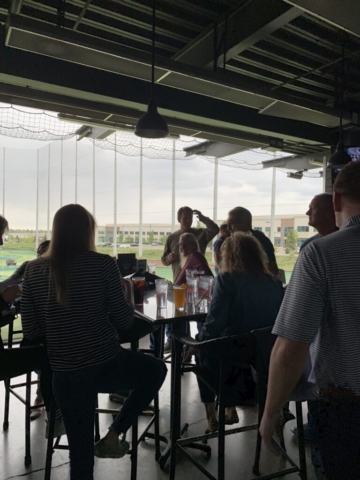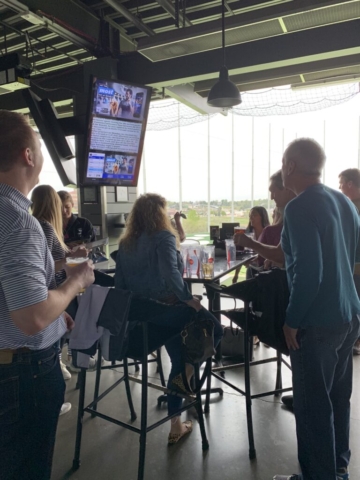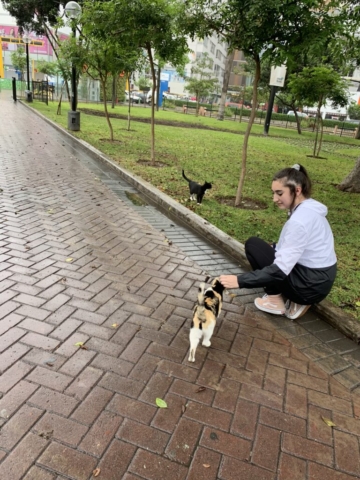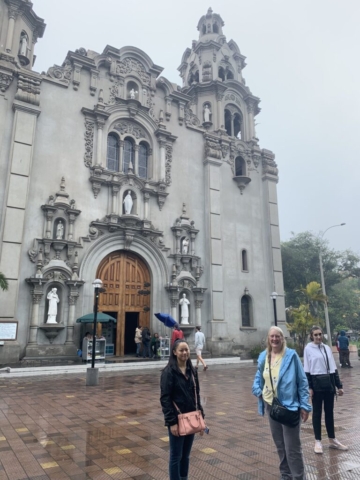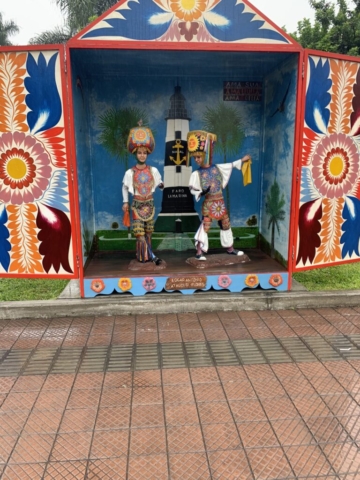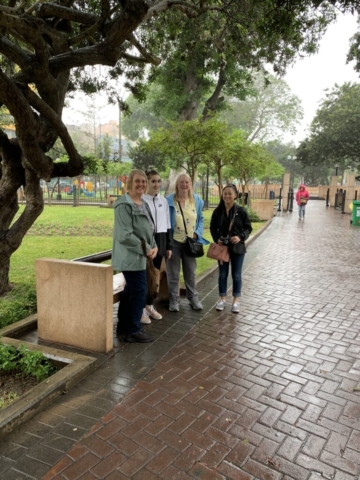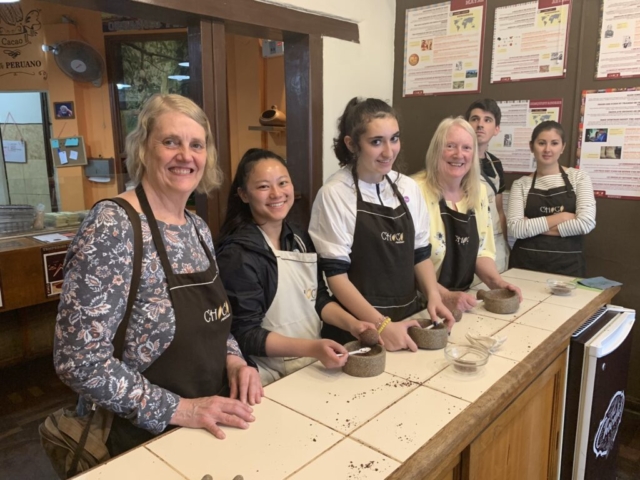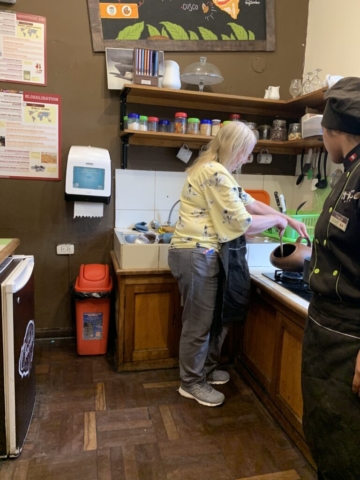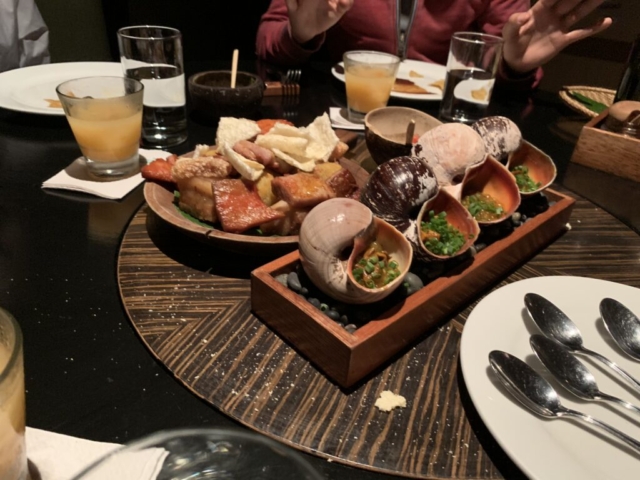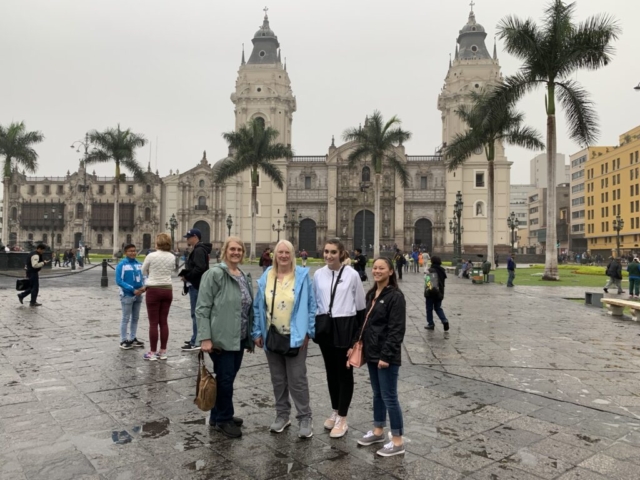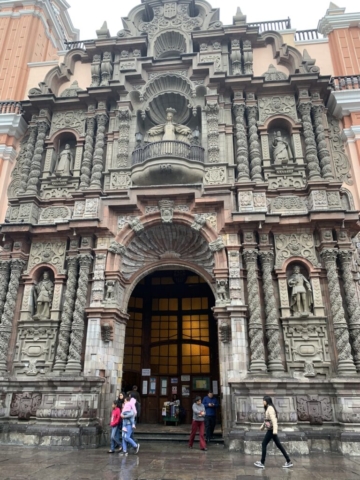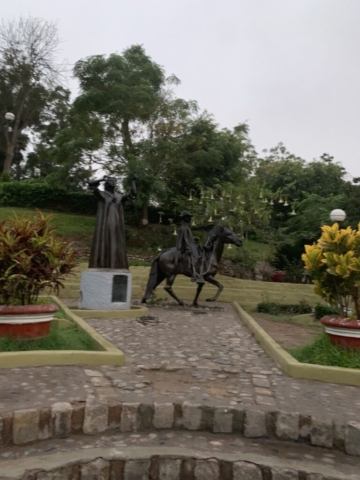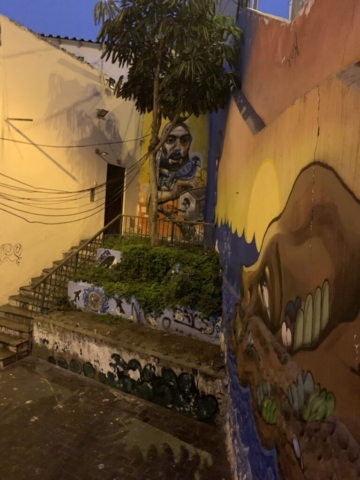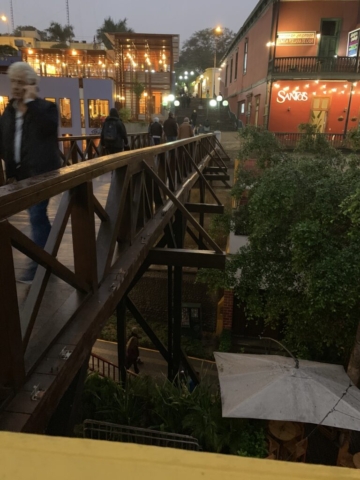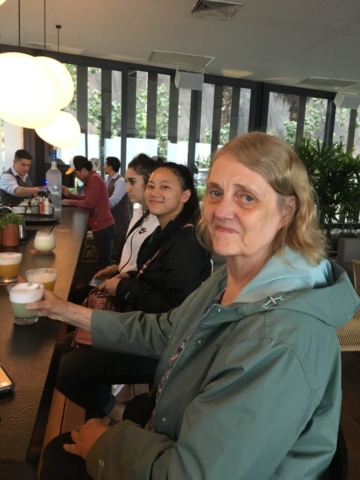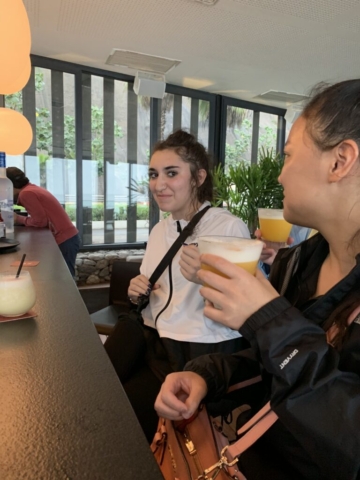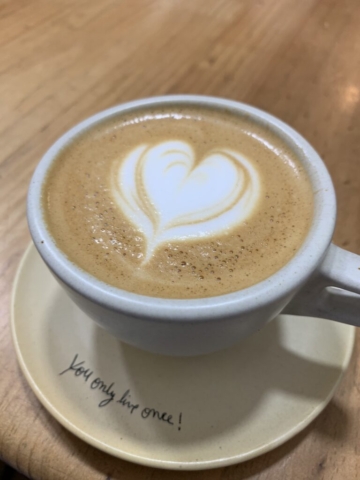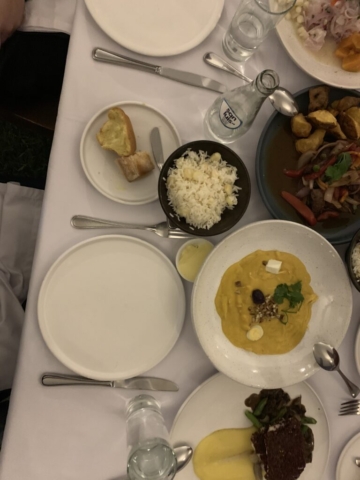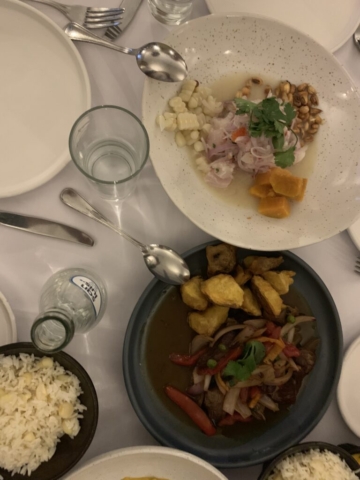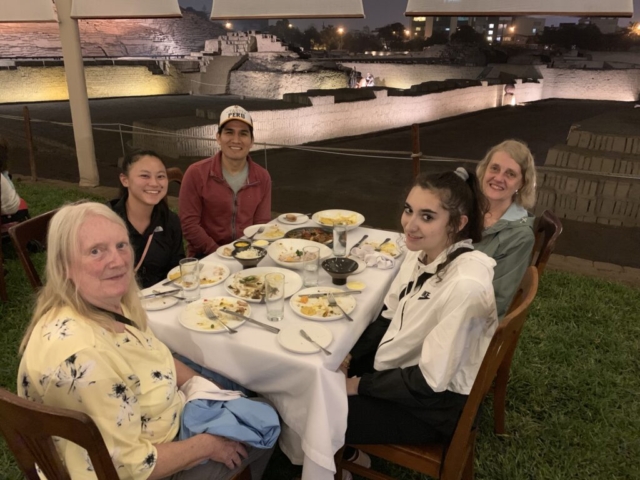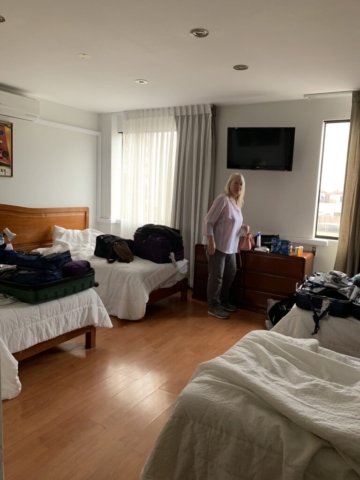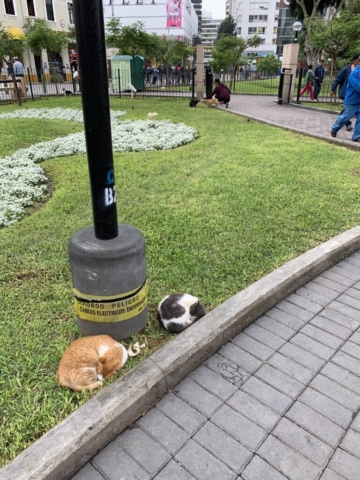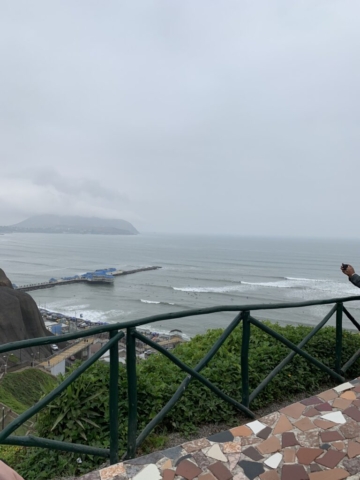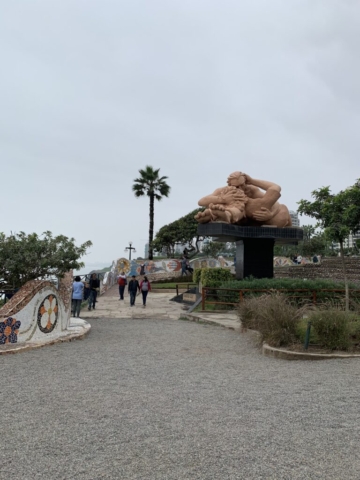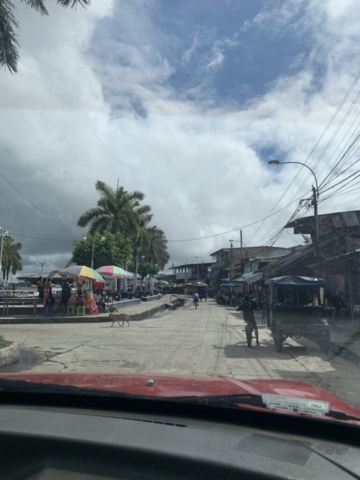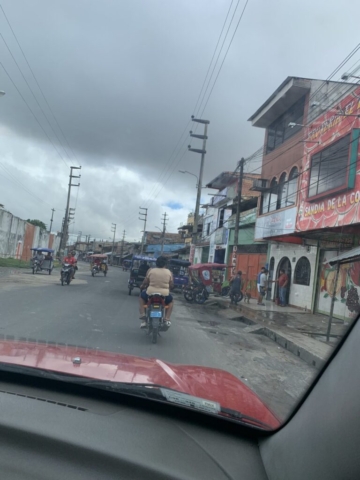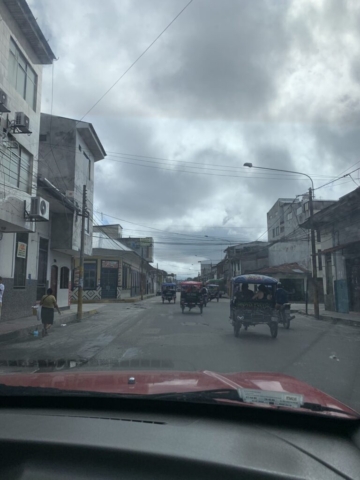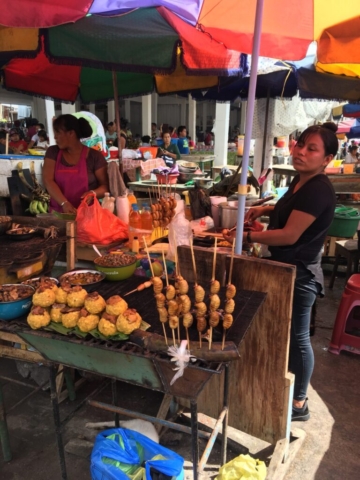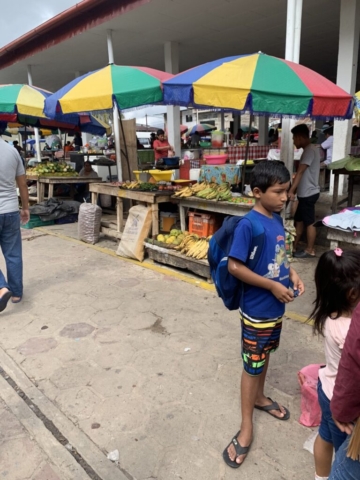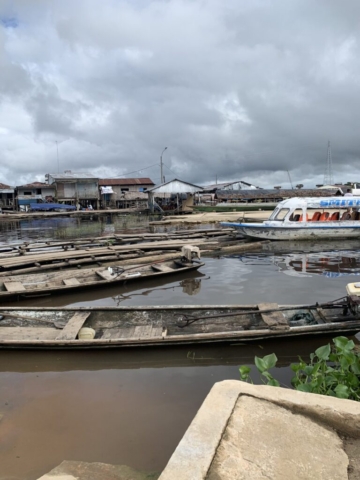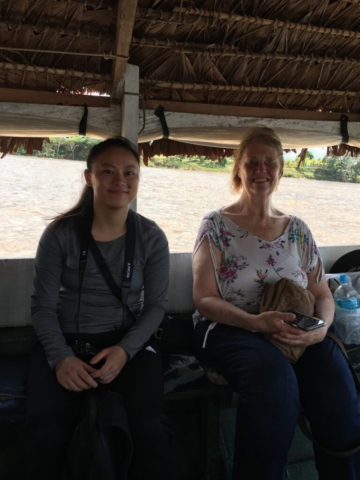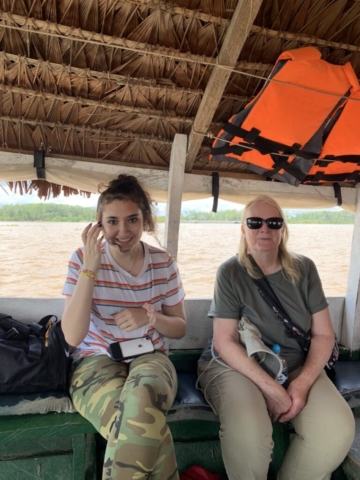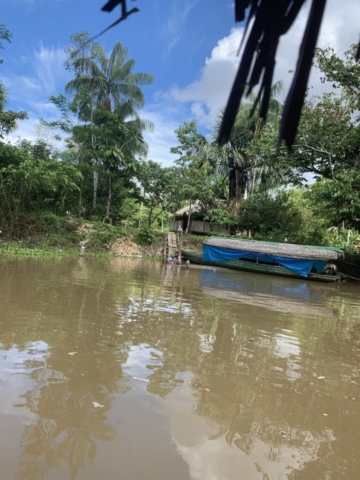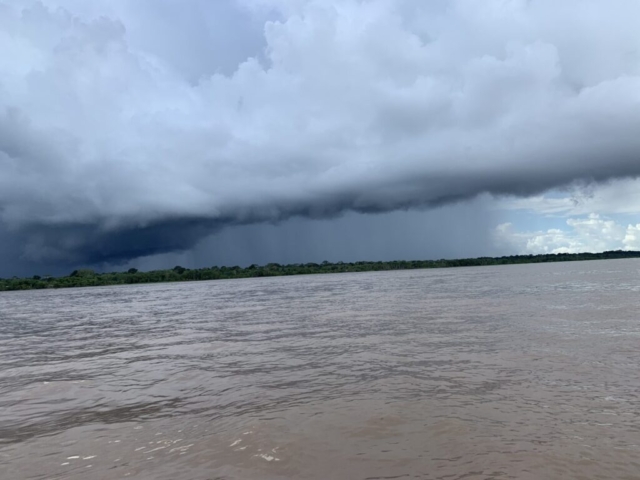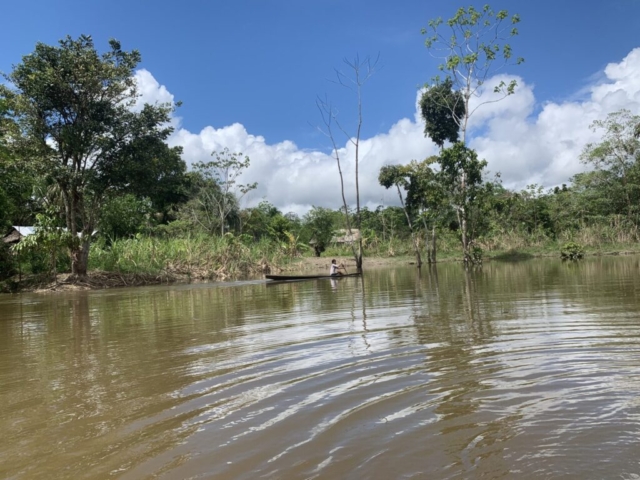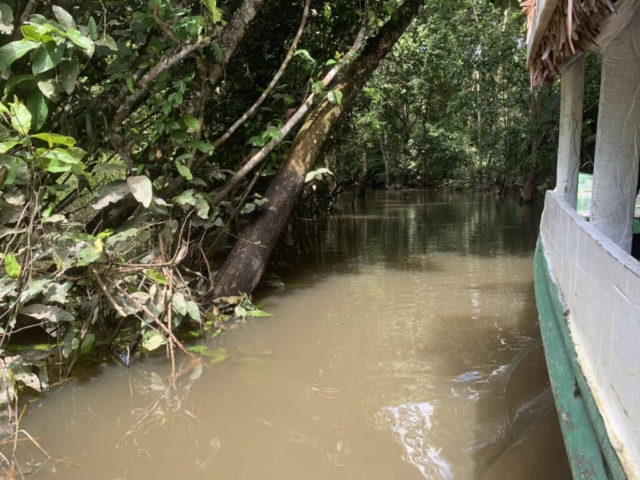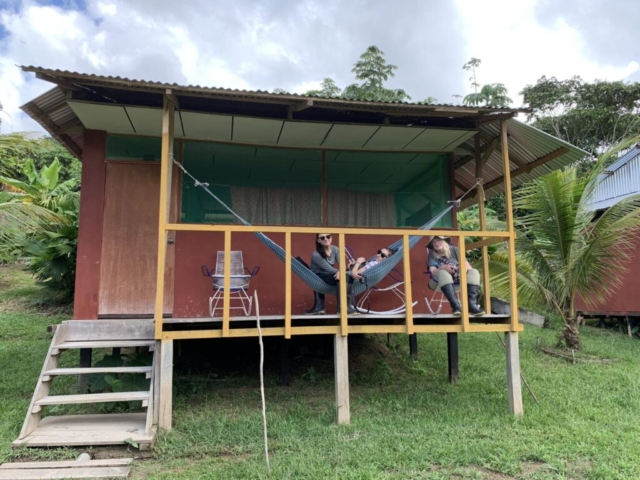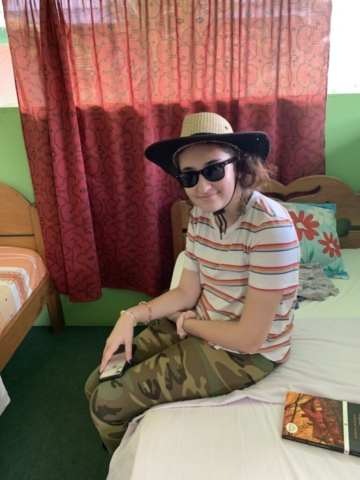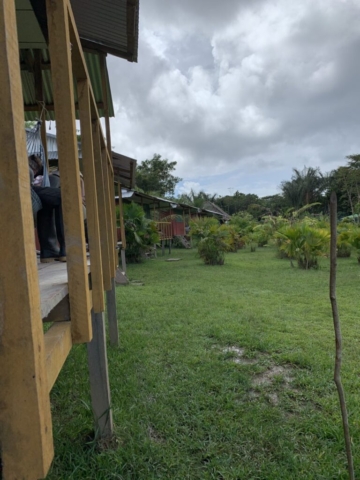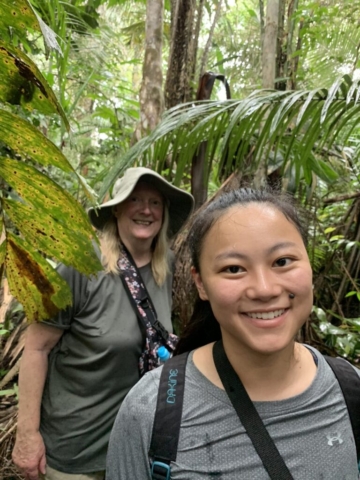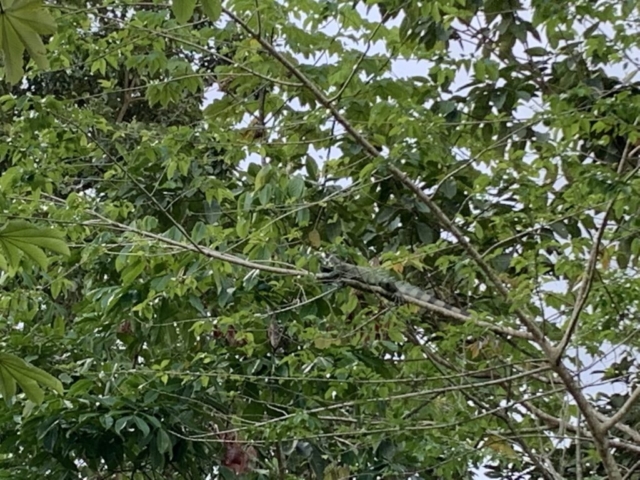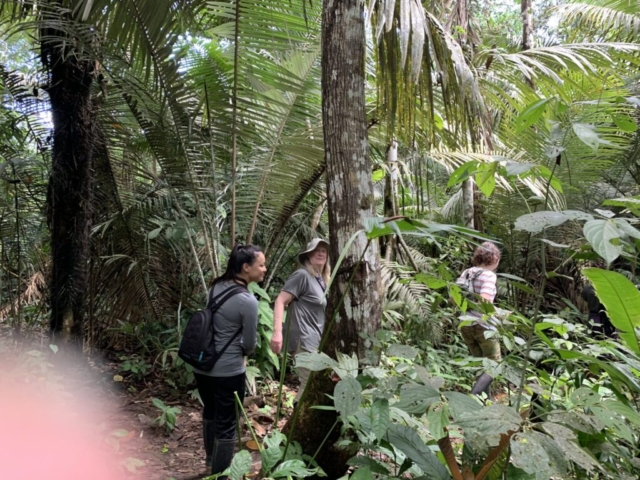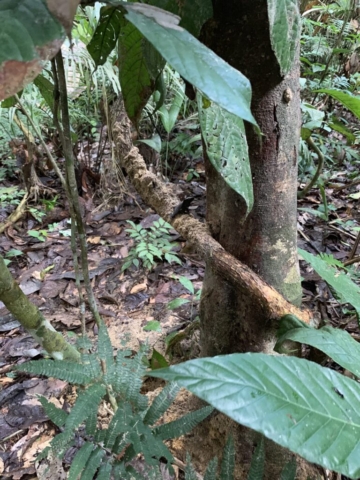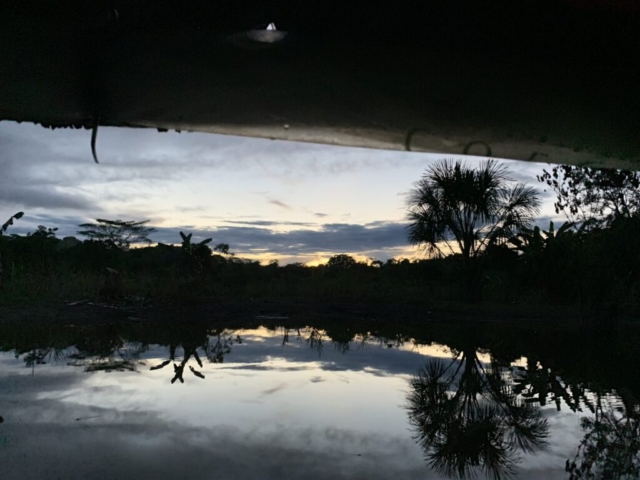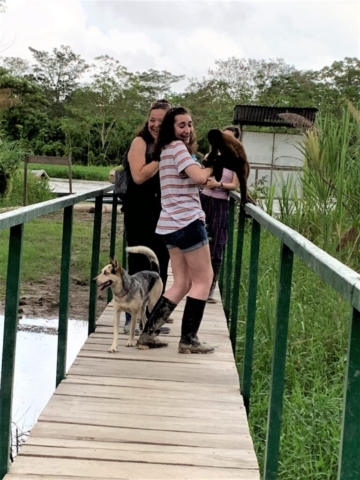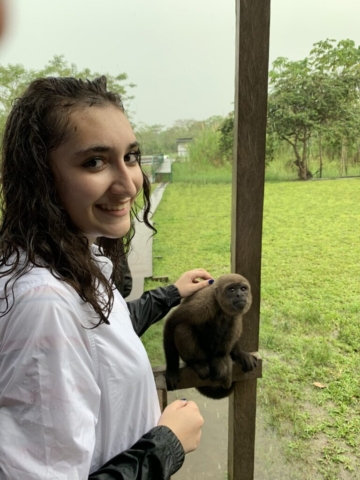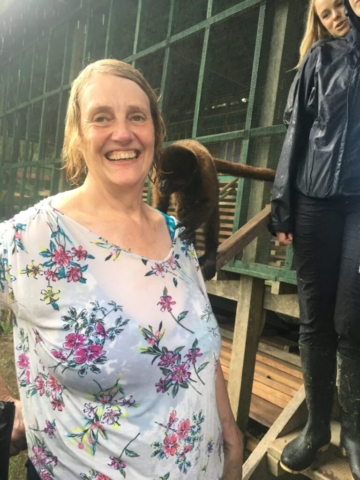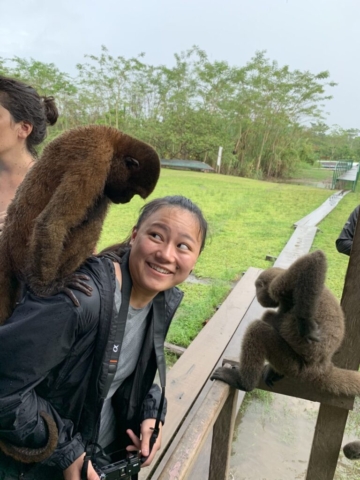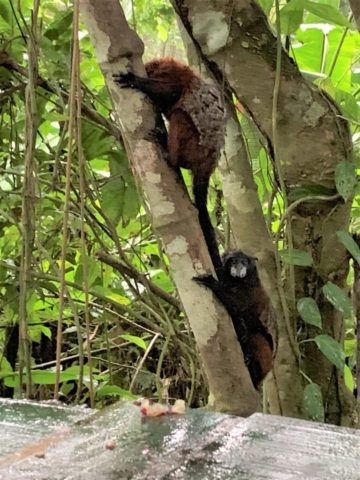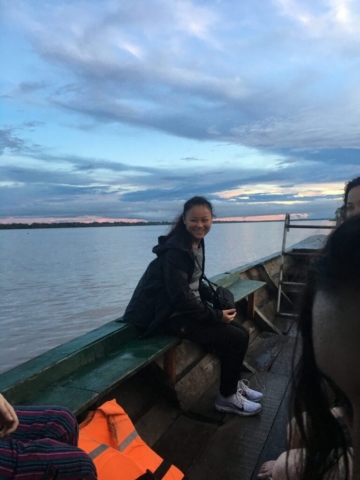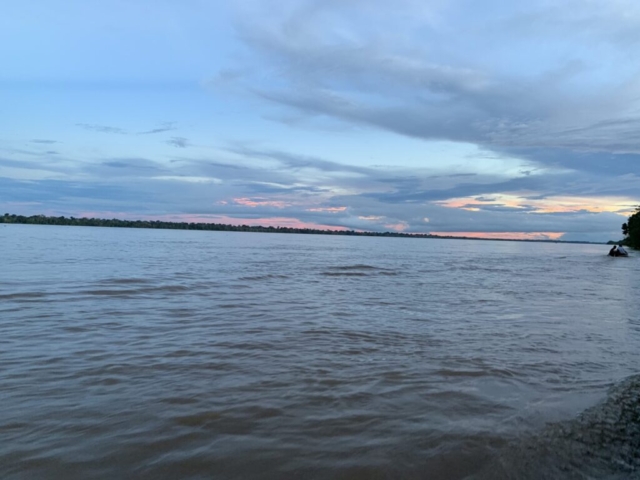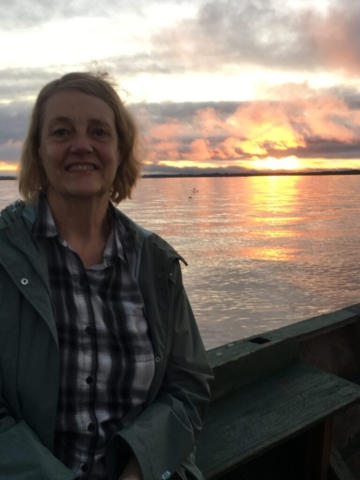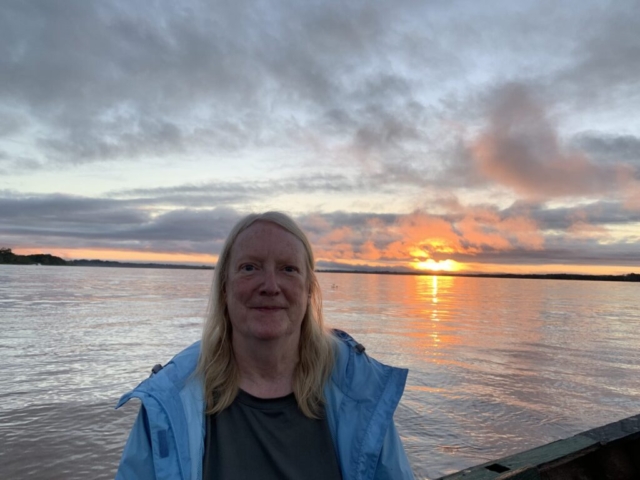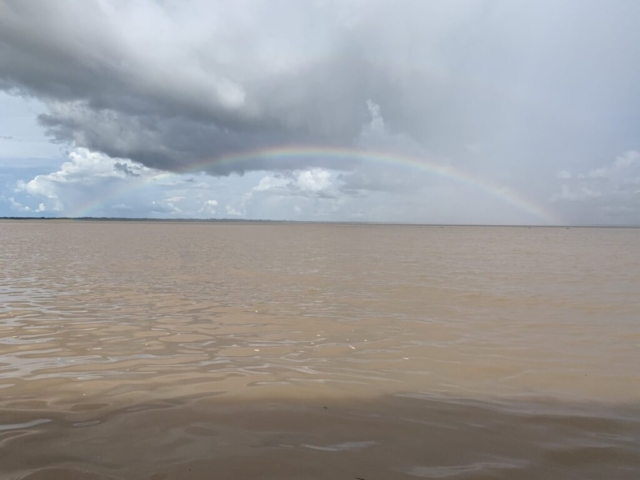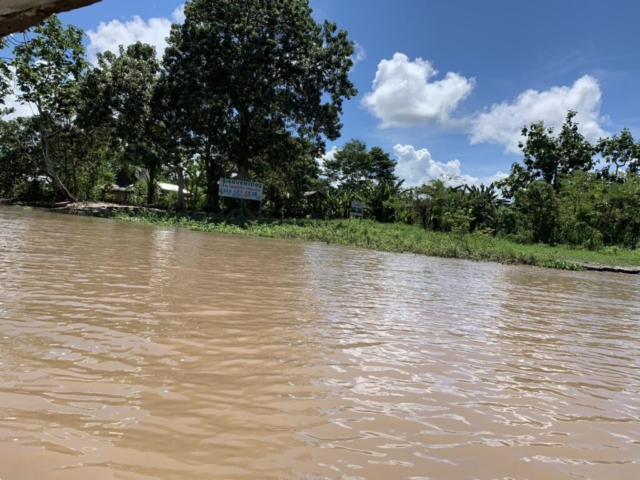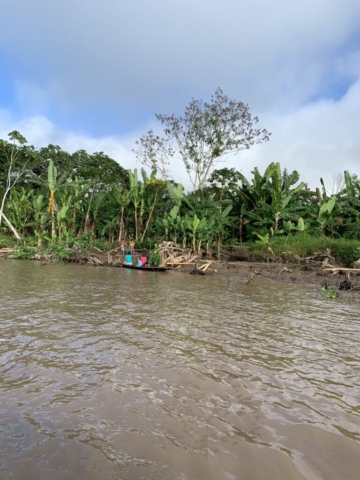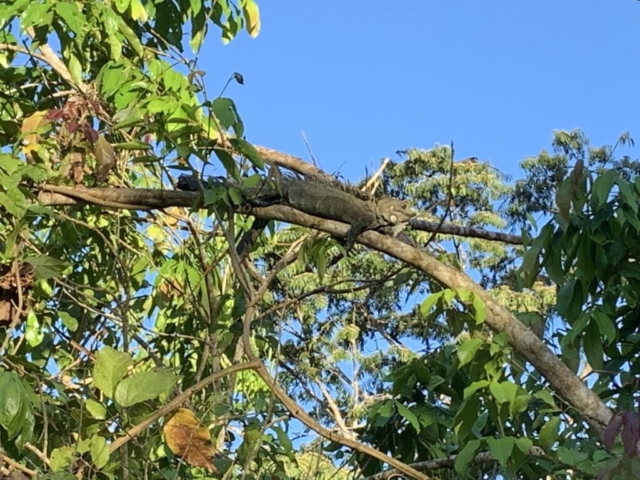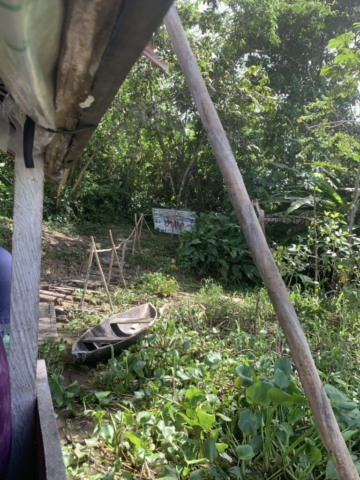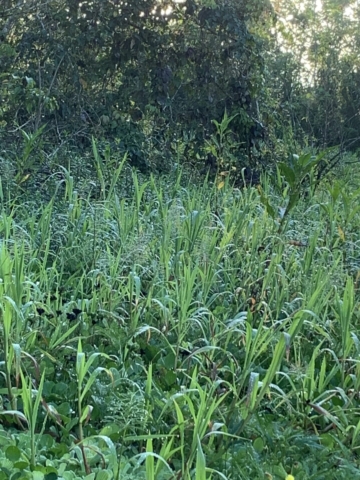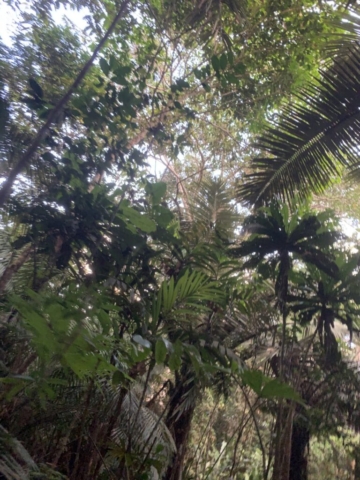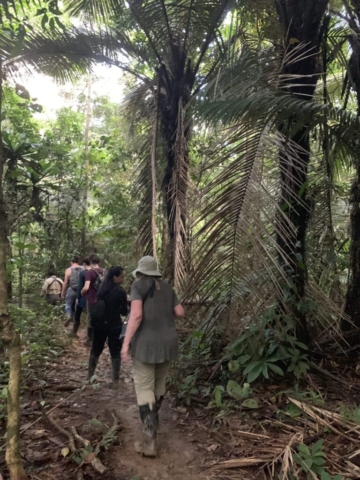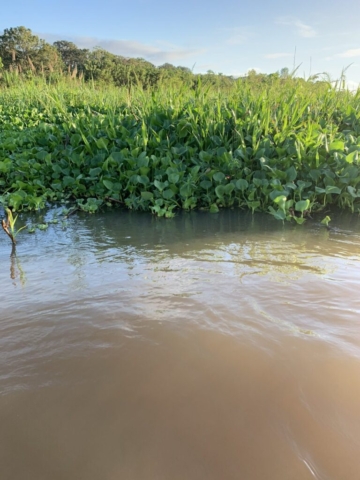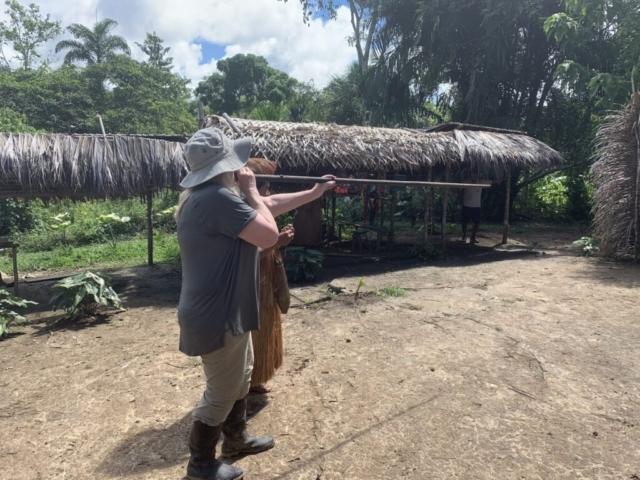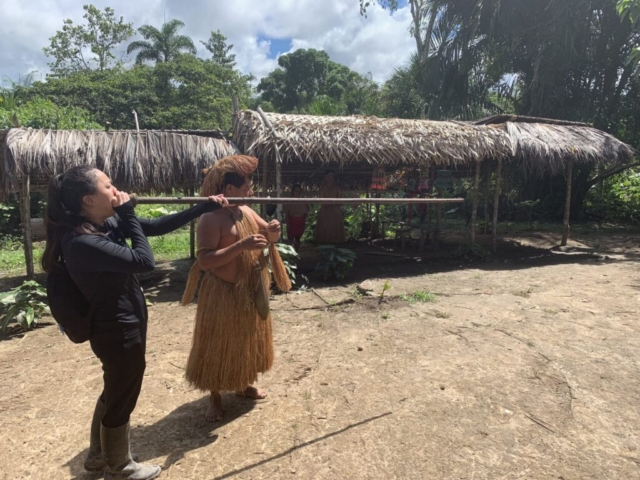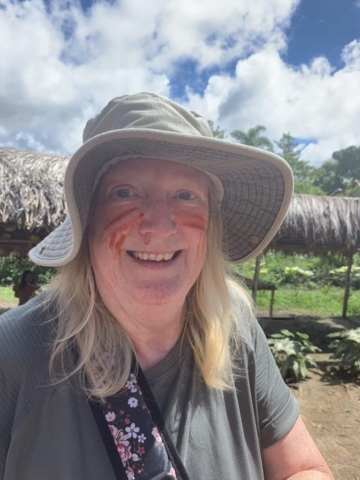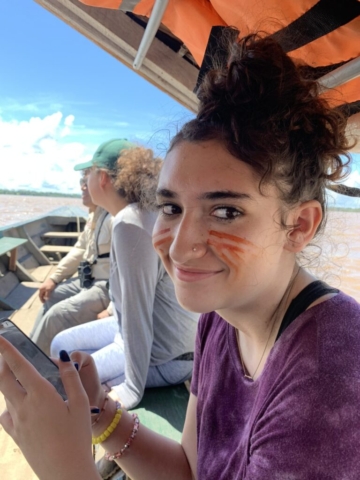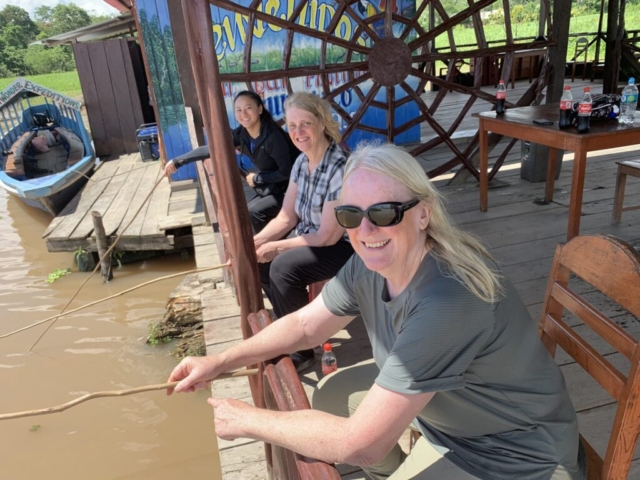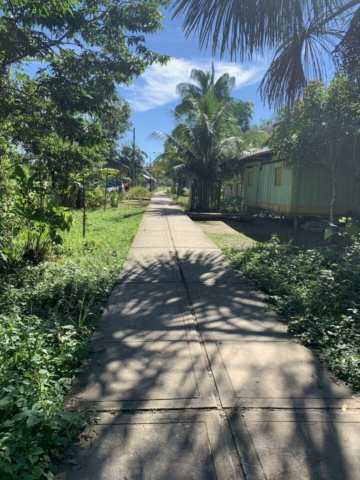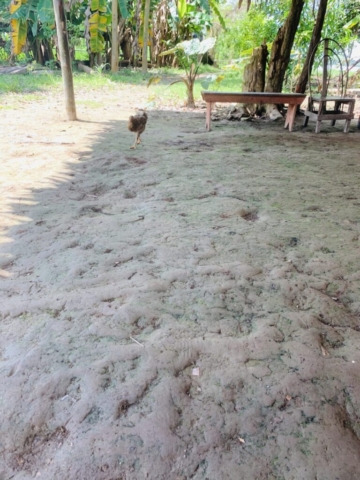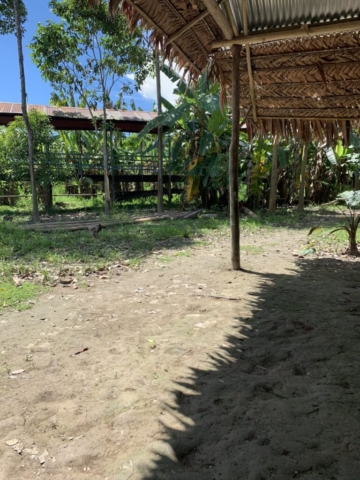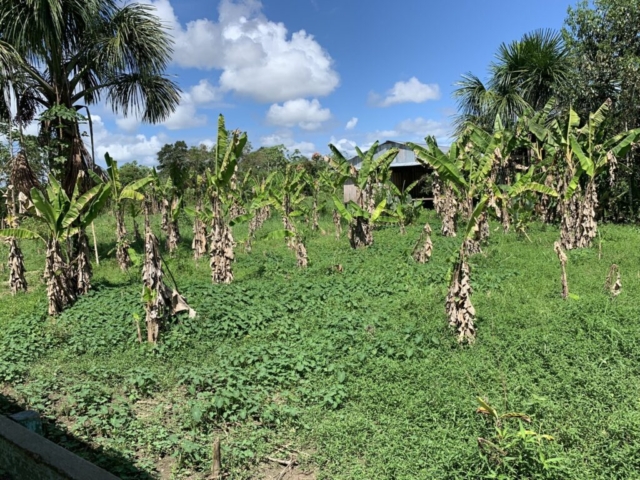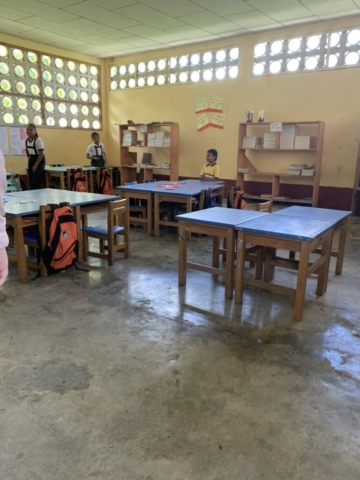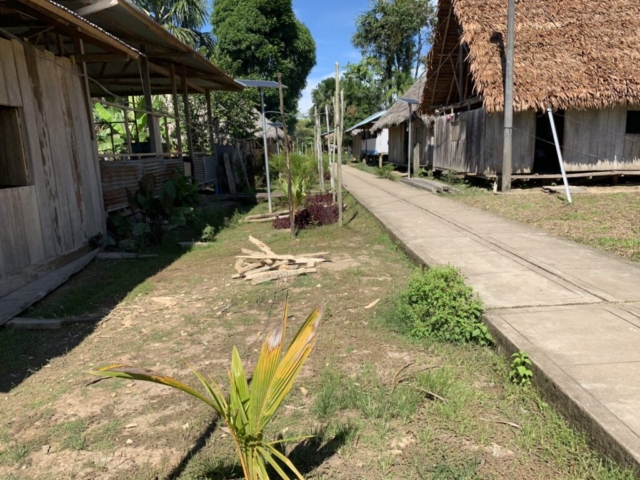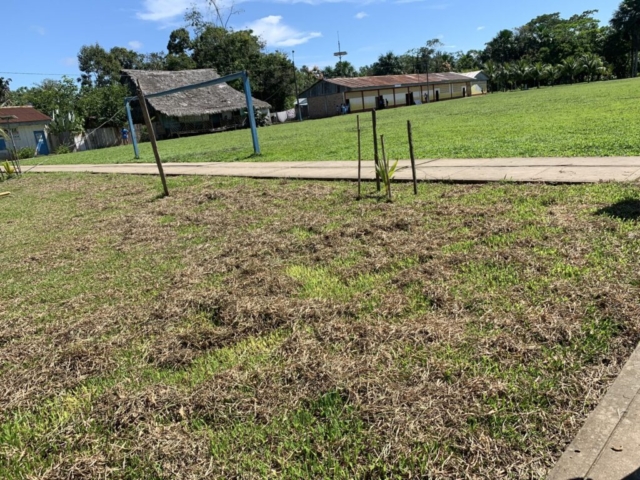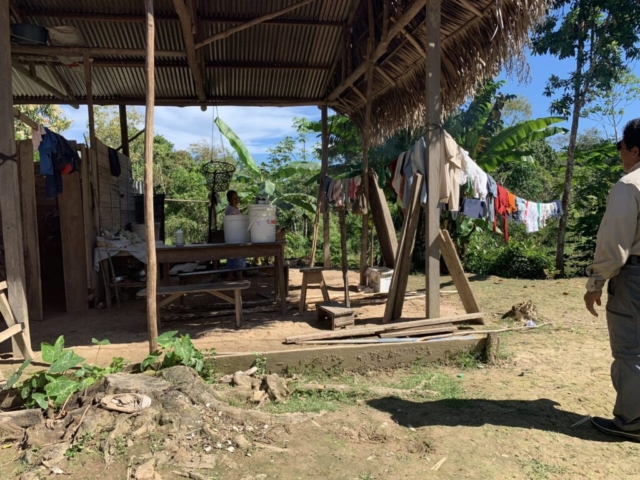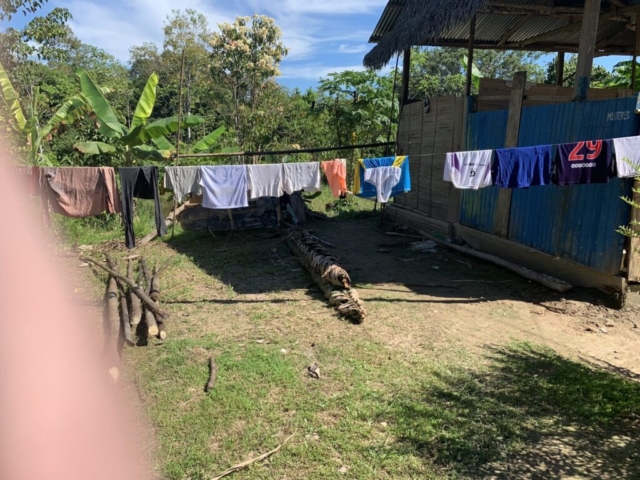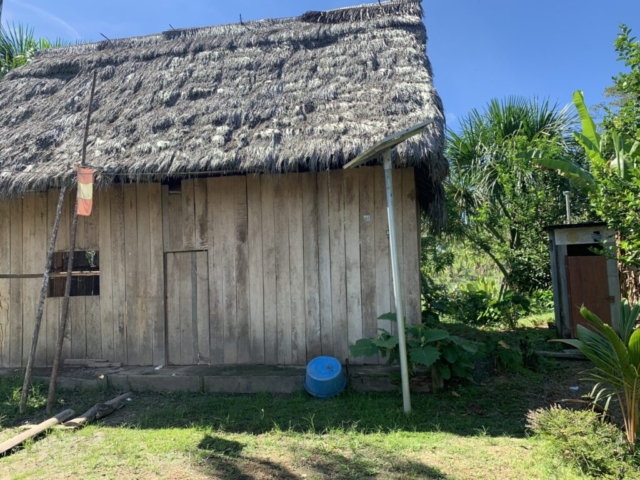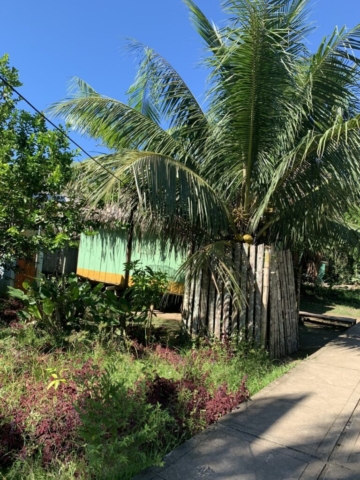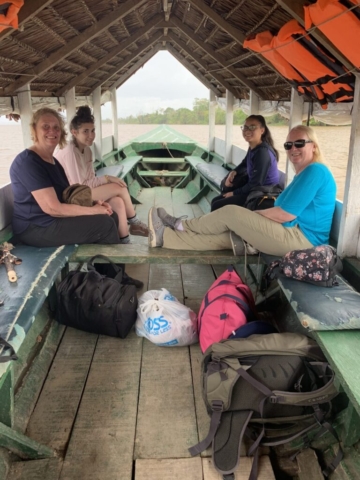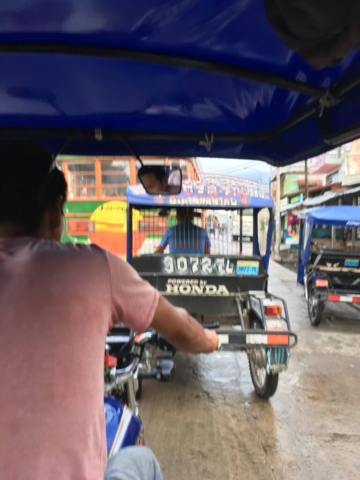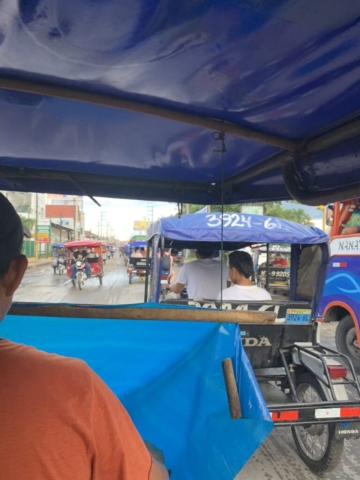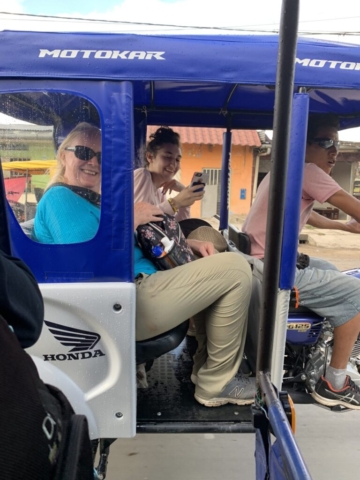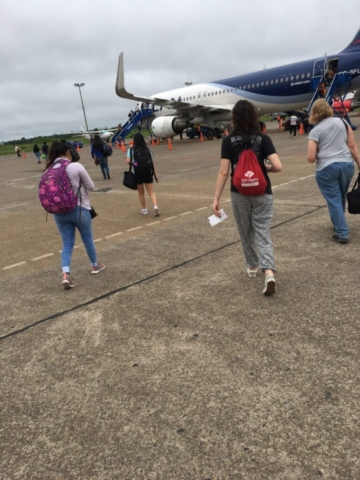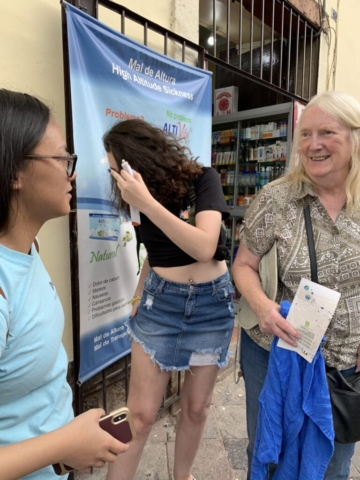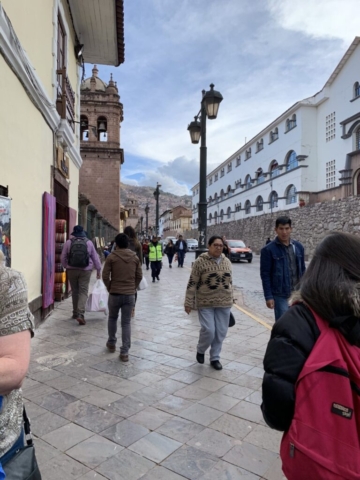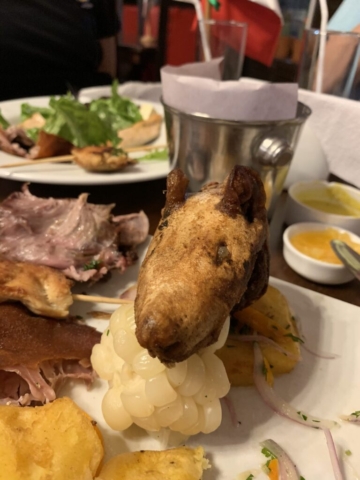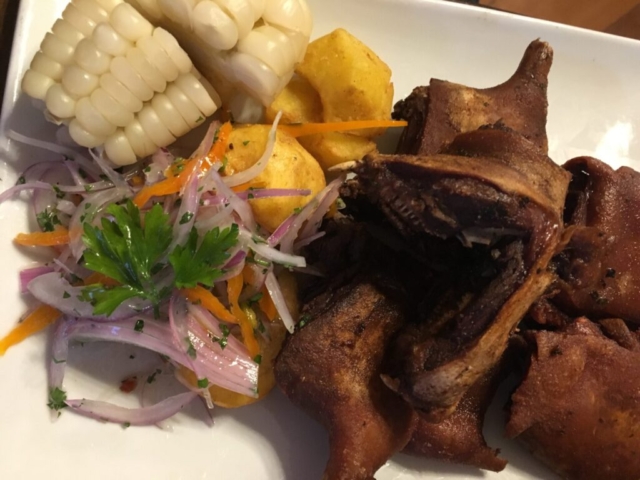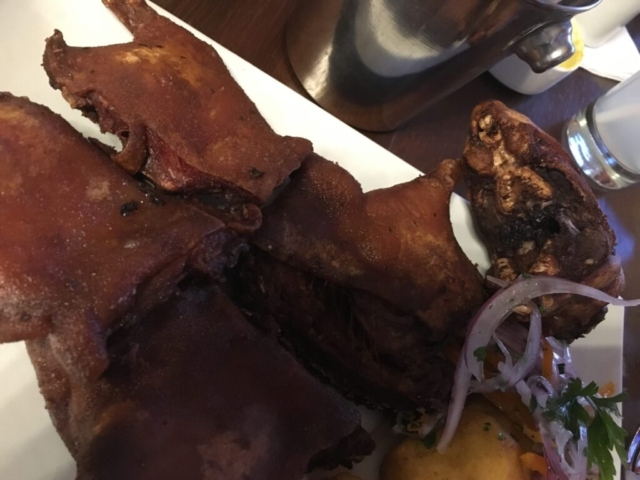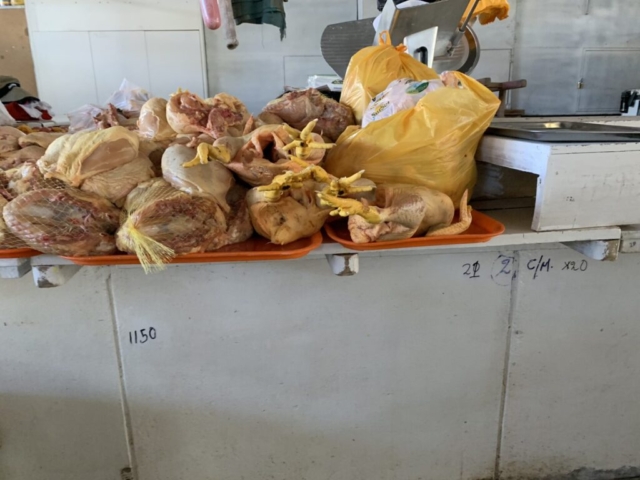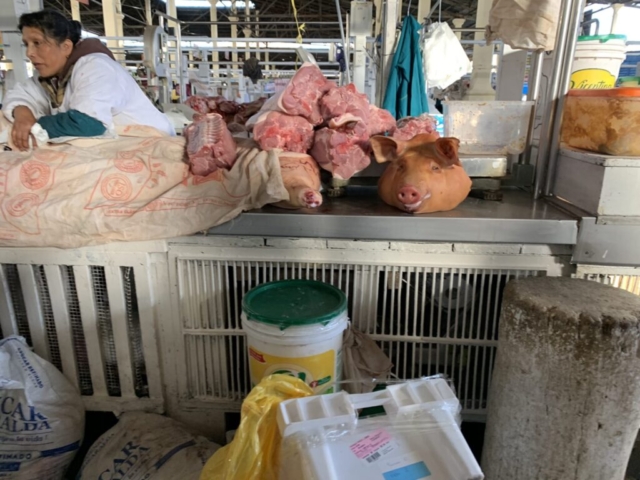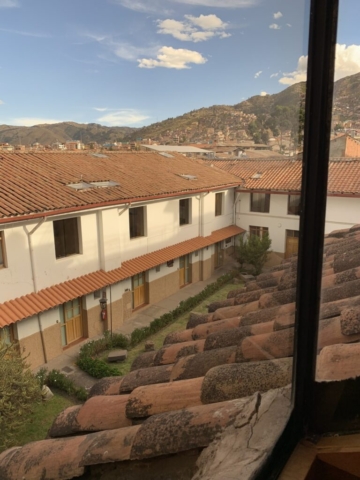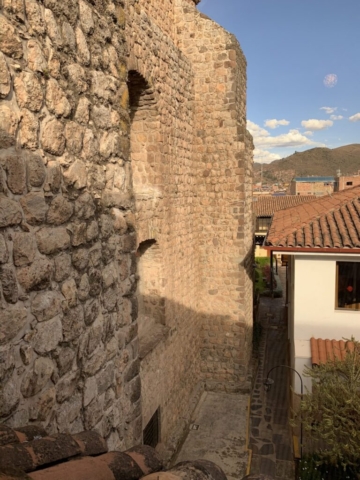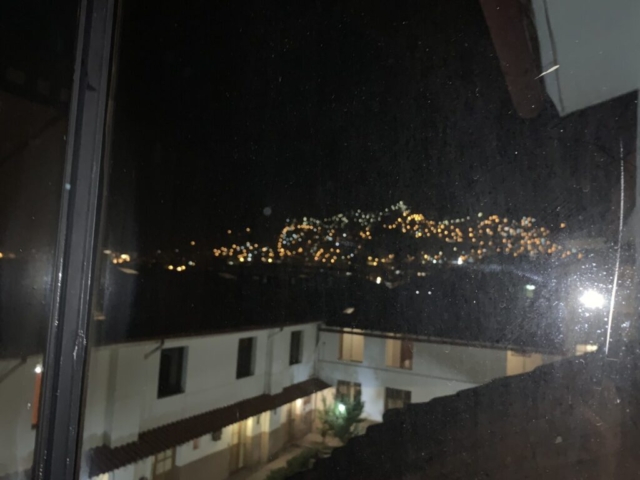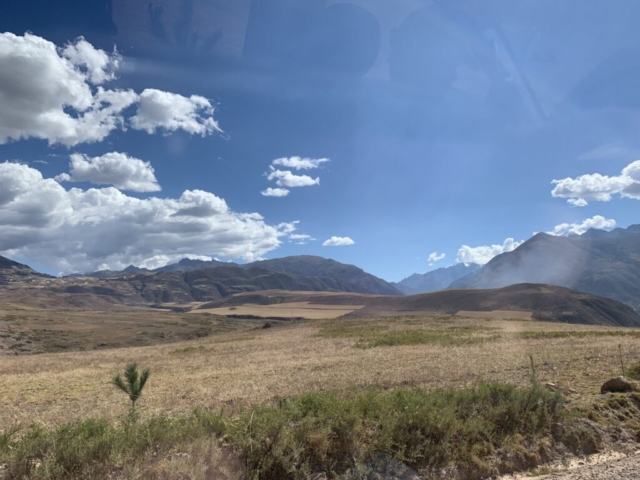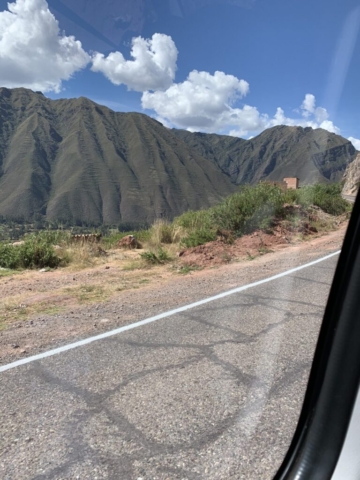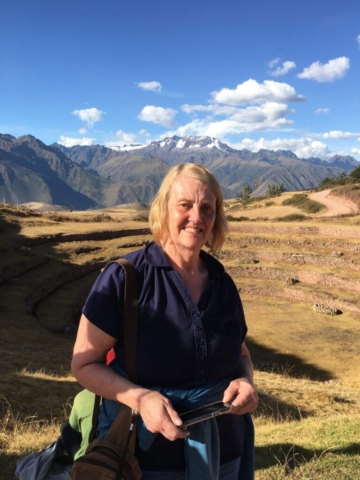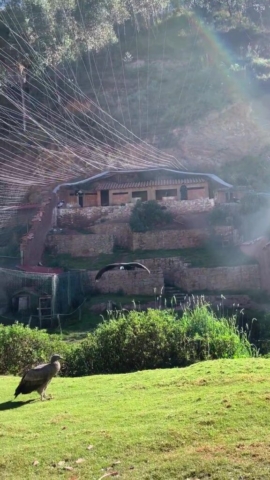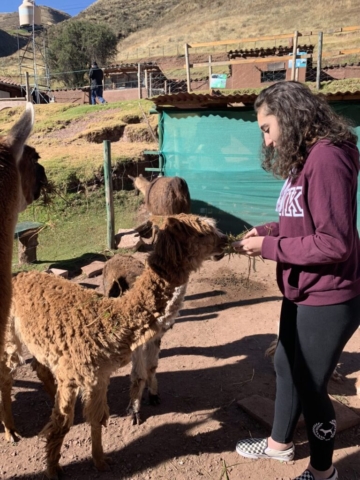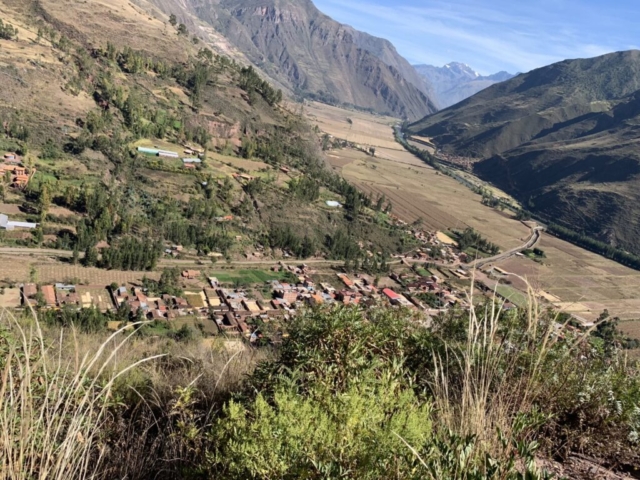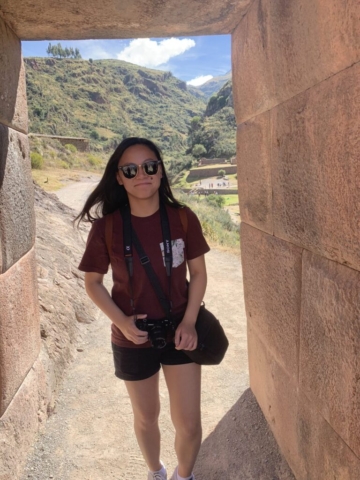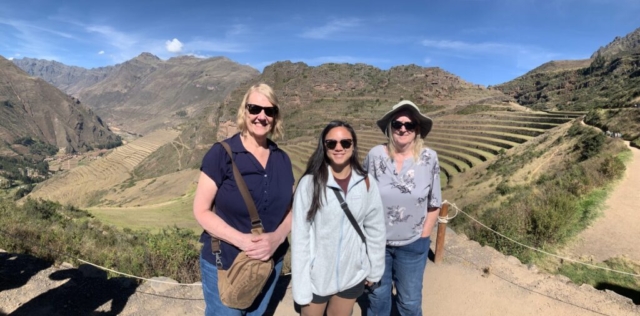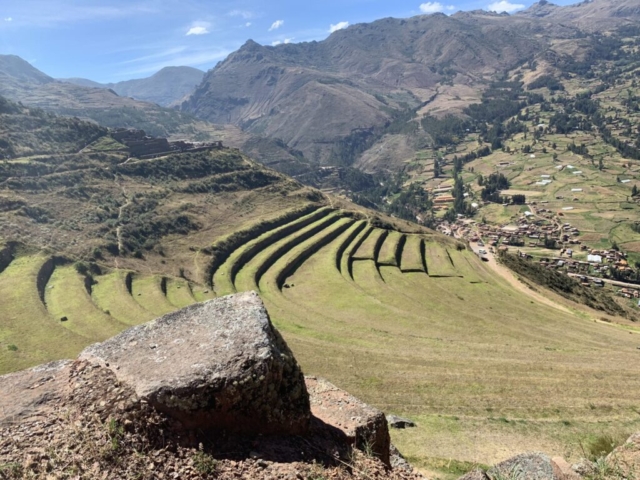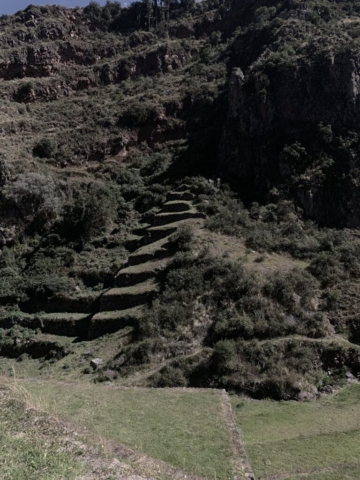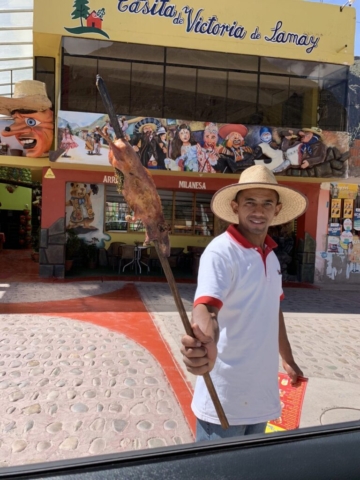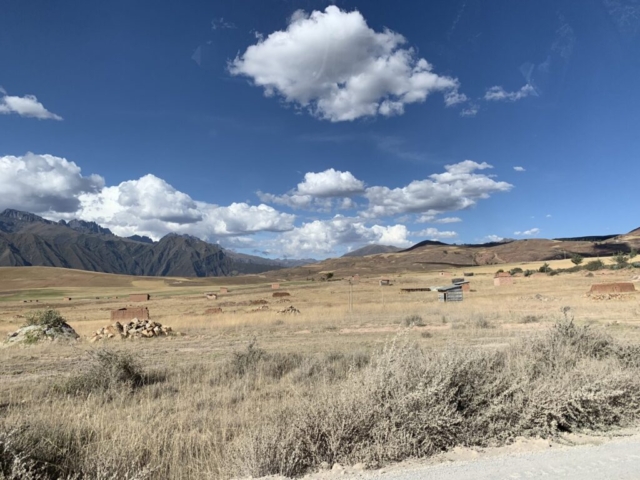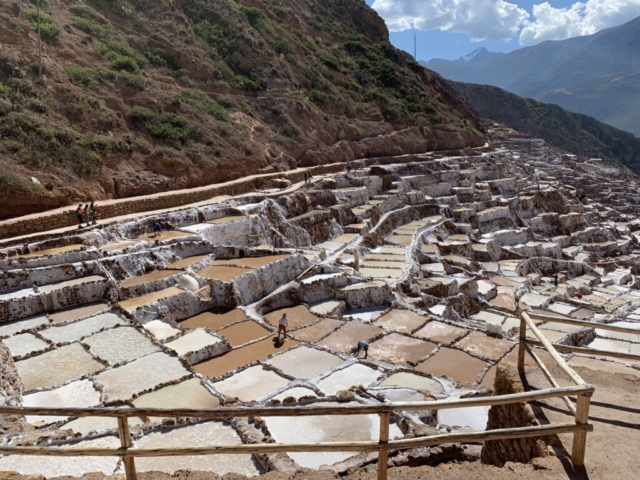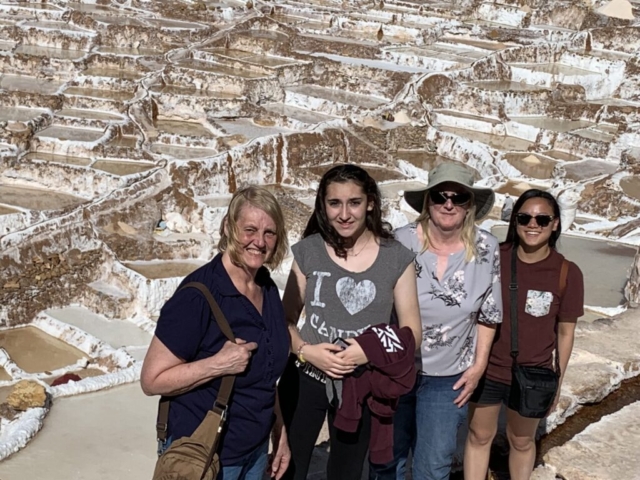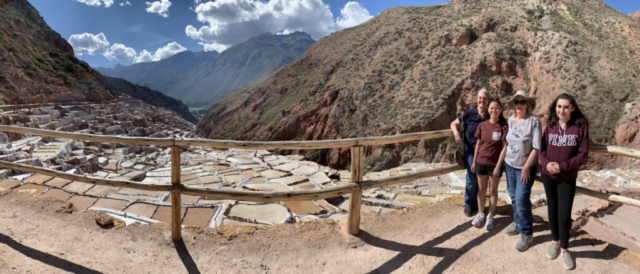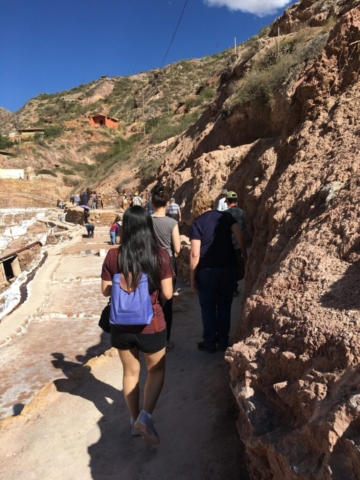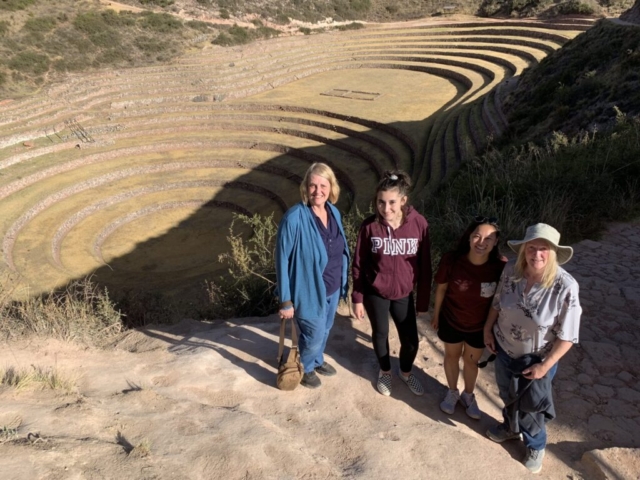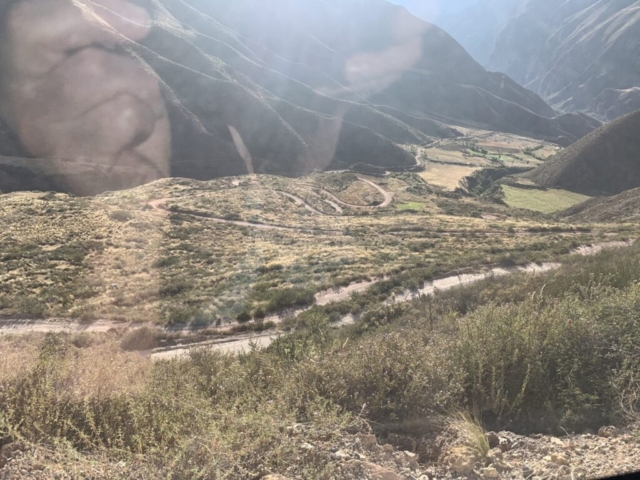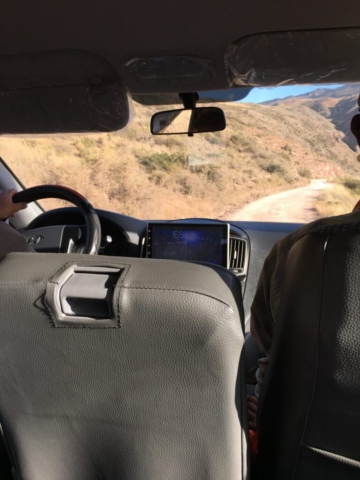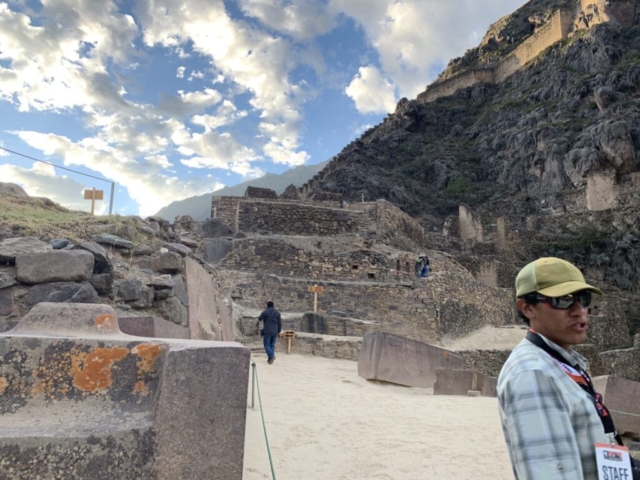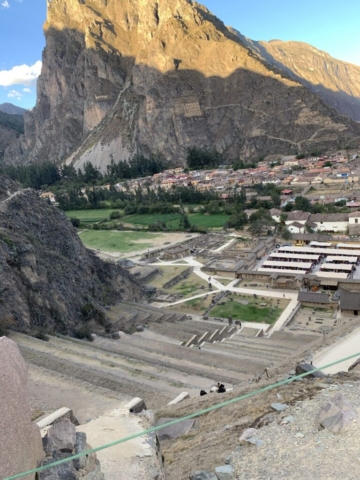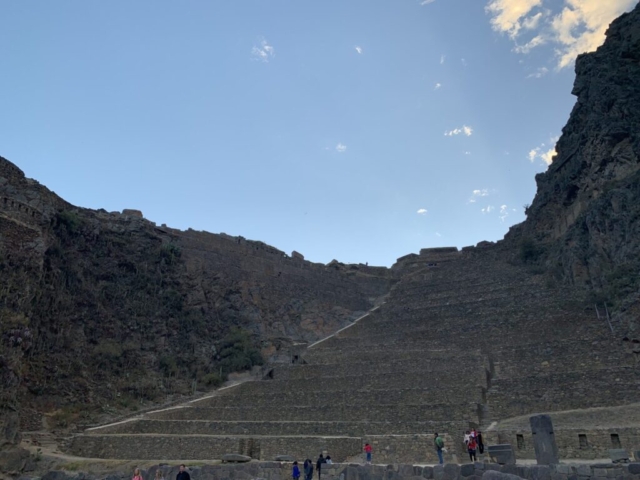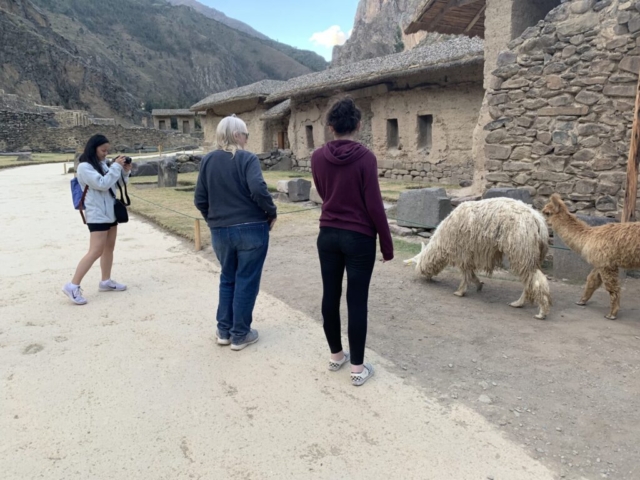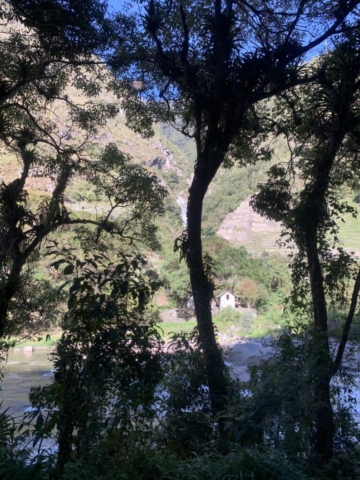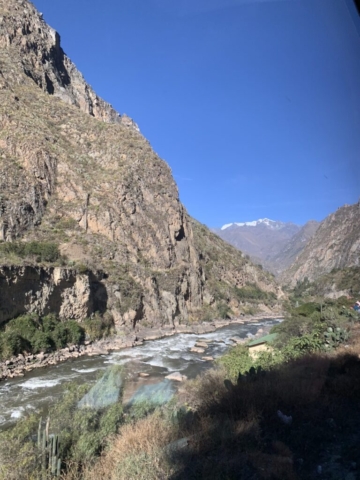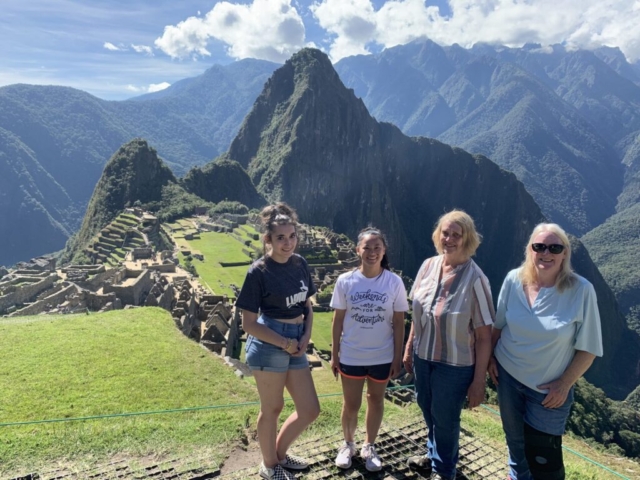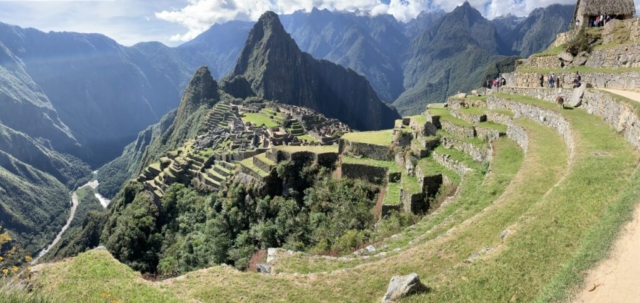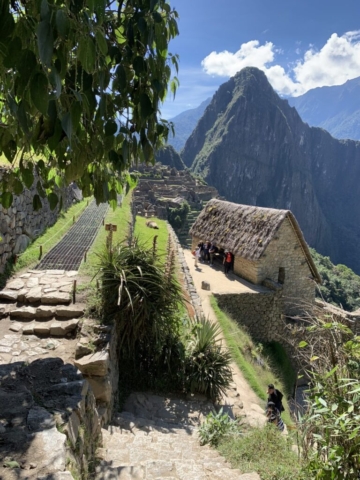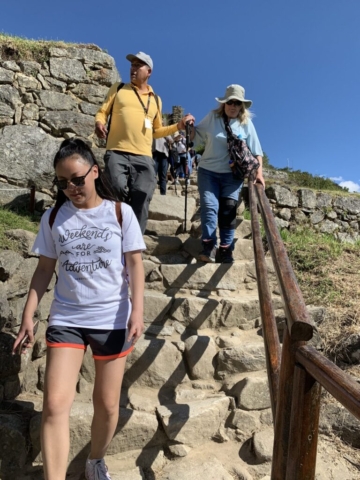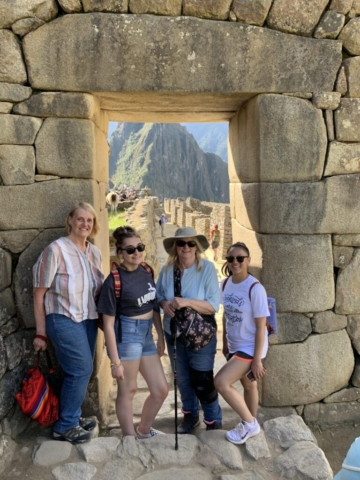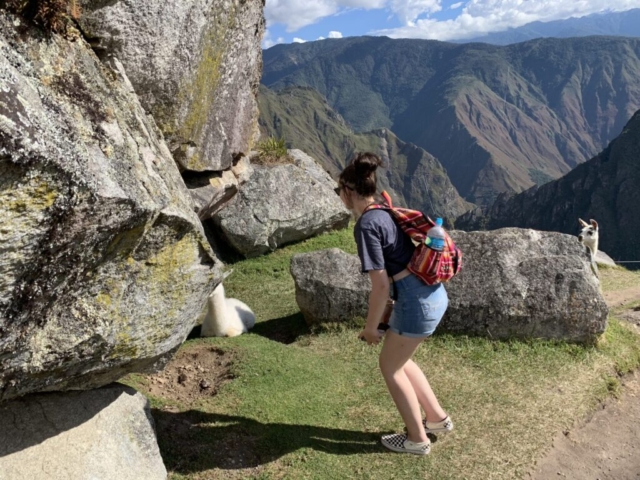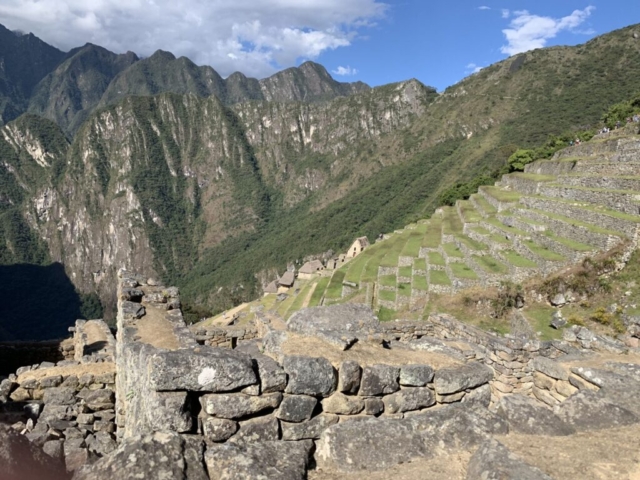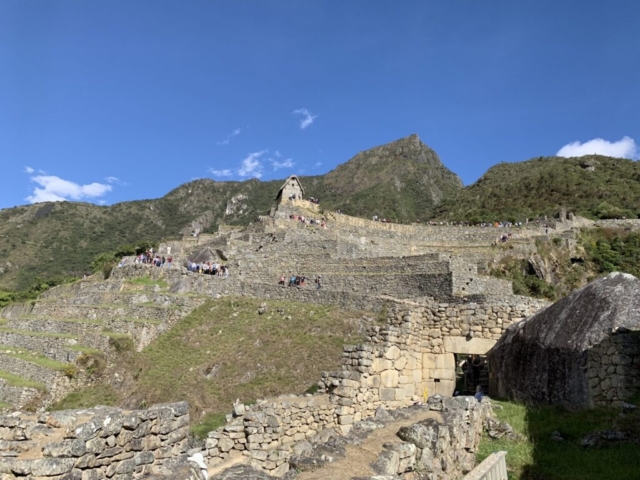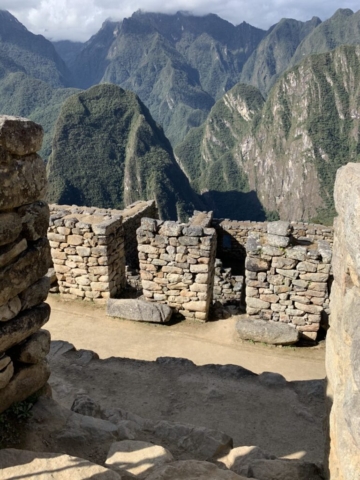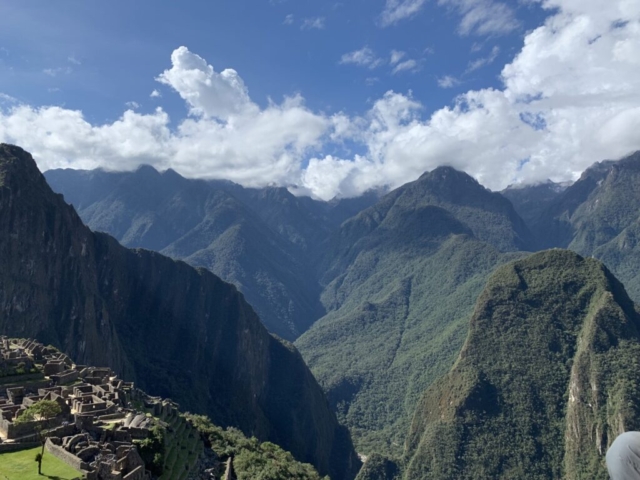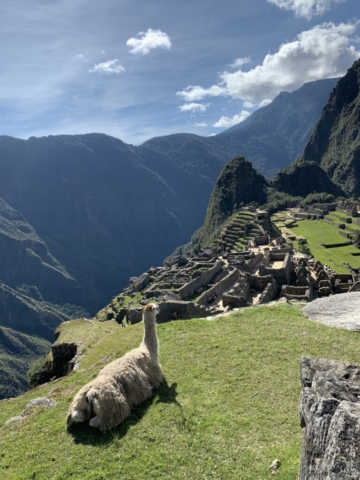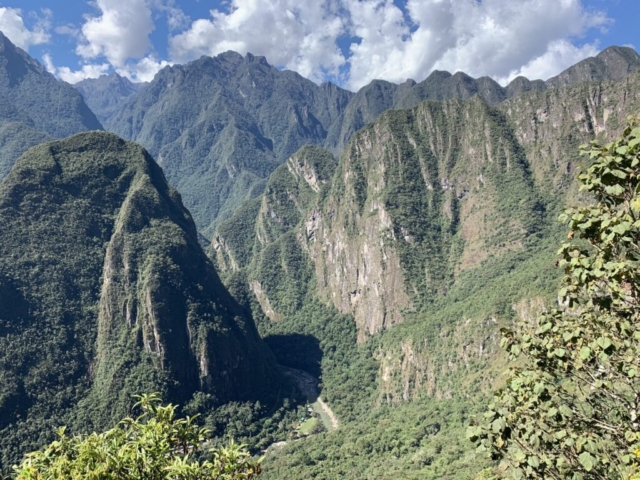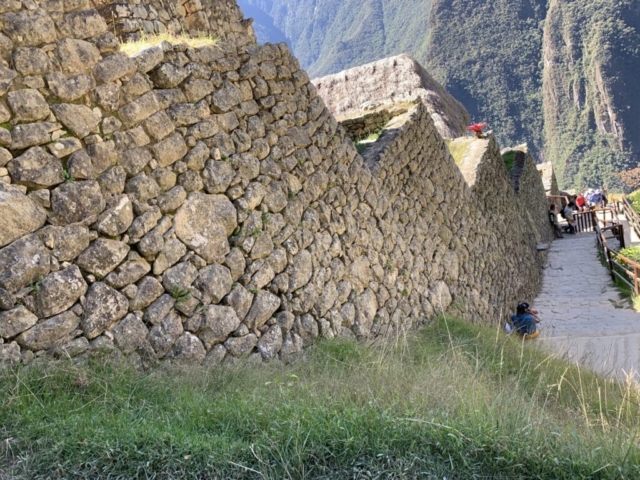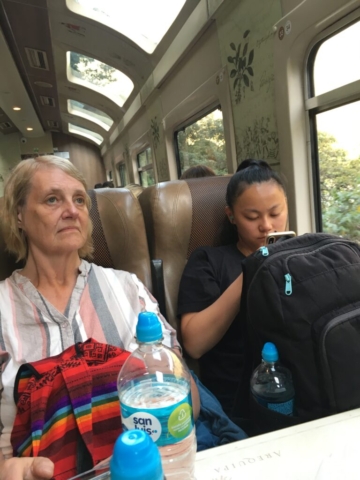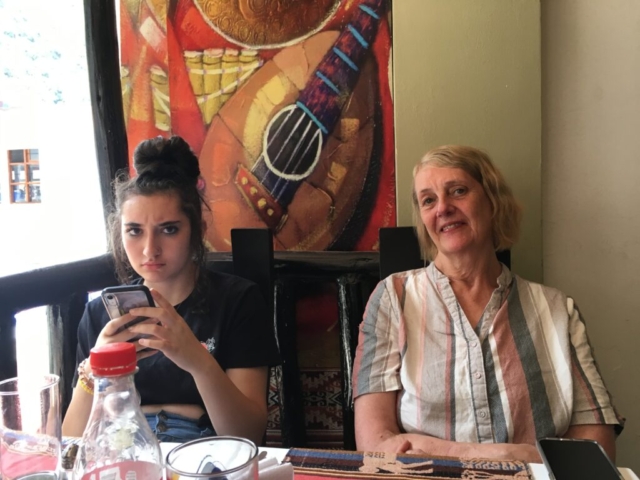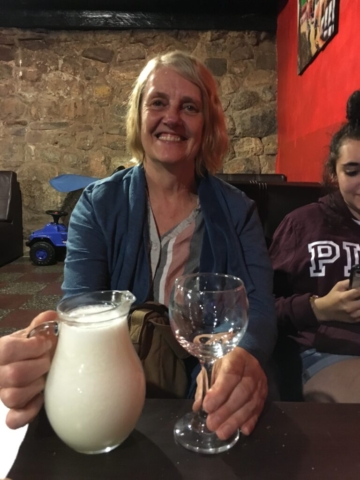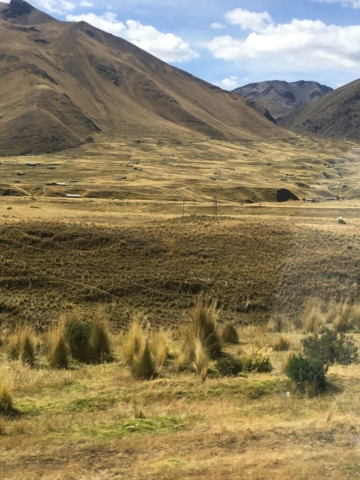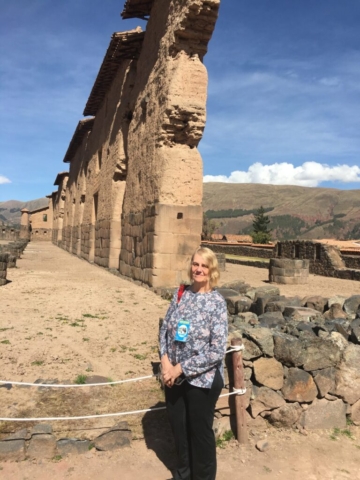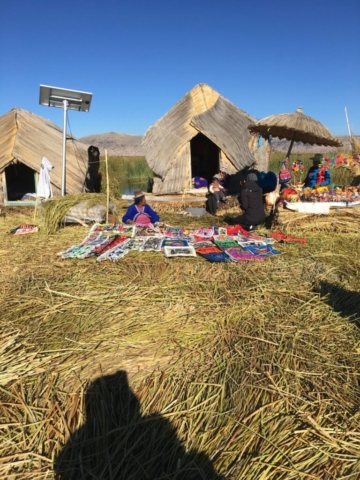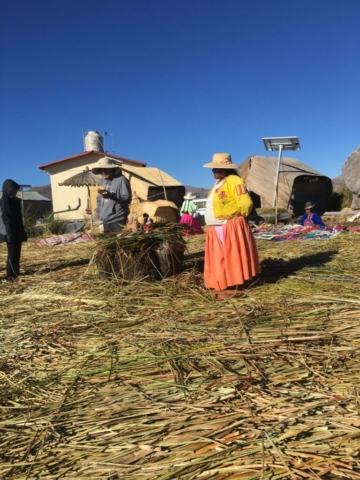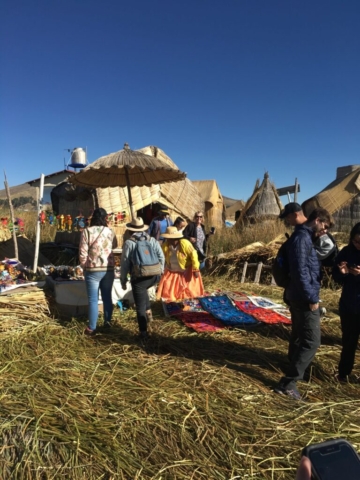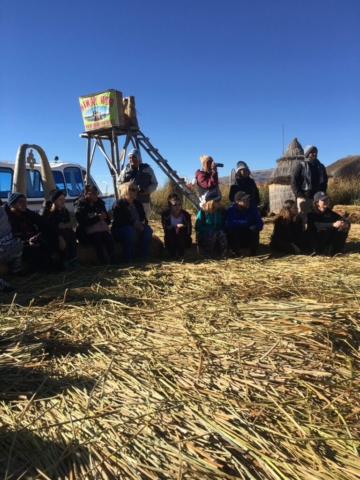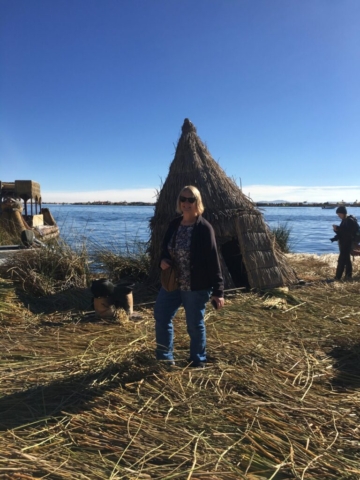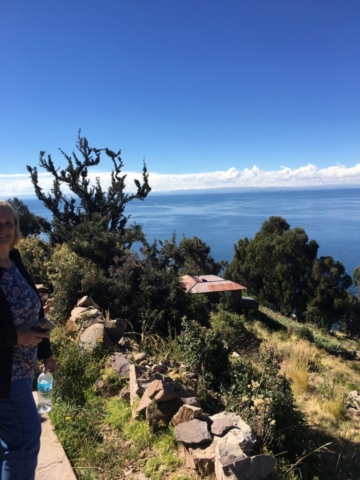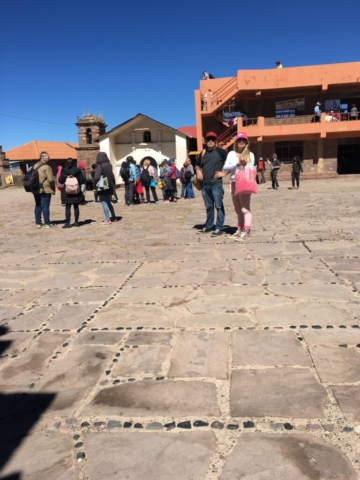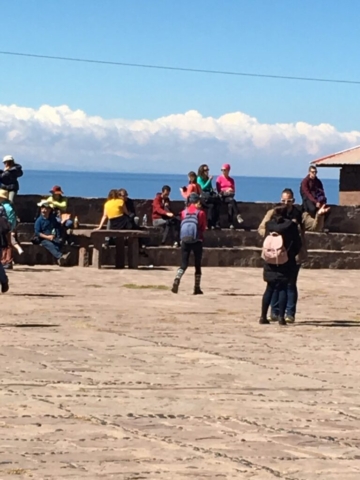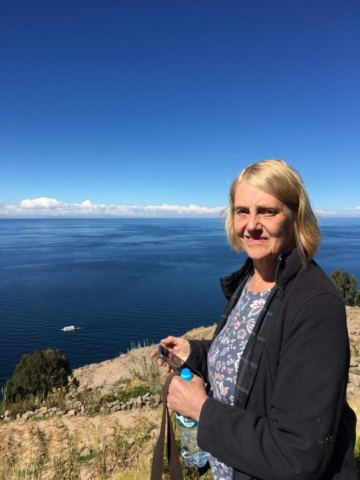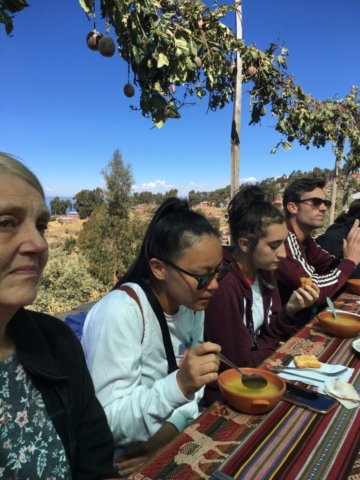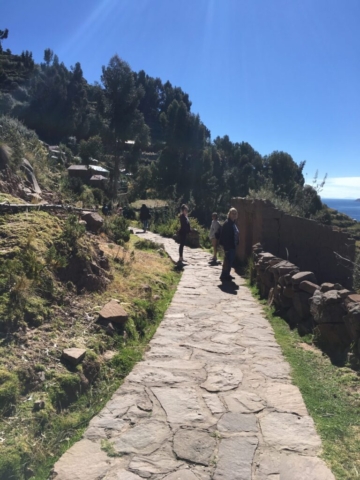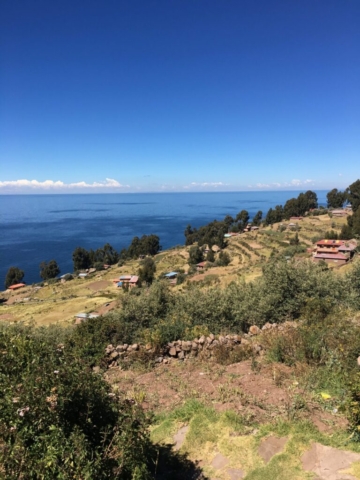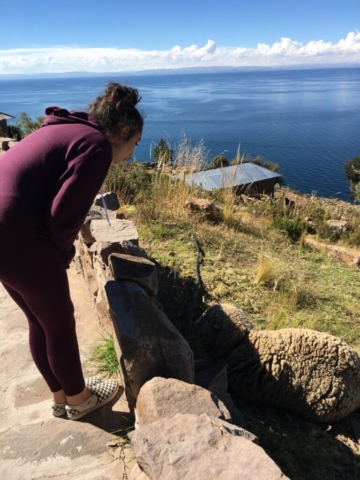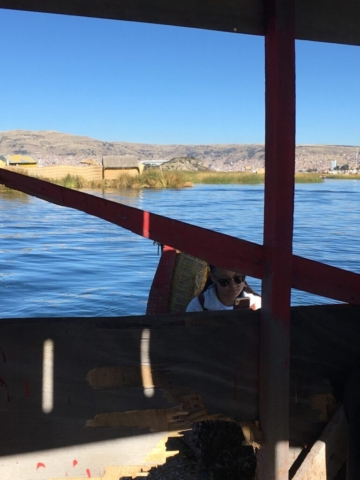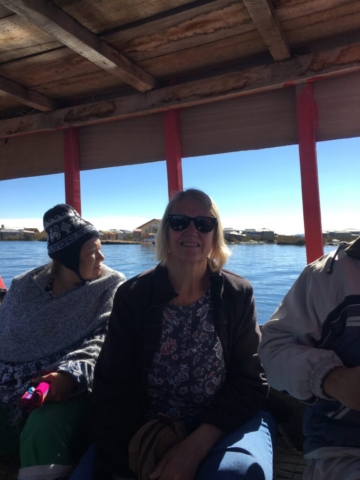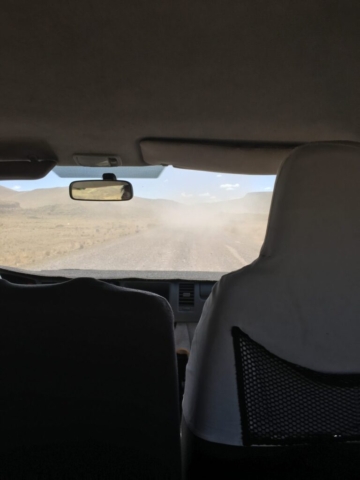May 22 – June 6, 2019
Because we went to the Amazon we had to get Yellow Fever shots, take Typhoid pills in advance and Malaria pills 2 days before going to the Amazon, while we were there and 7 days after.
Photos are at https://verylessite.shutterfly.com/ this needs work but won’t happen for awhile. The name of the photo tells what it is.
May 22 – Debbie flew in and we met at Top Golf for family fun
May 23 – This was a travel day. We flew Denver to Dallas, Dallas to Miami and Miami to Lima. Our first flight was at 6:15 AM, so we left home at 4 AM. We arrived in Lima at 10:10 PM. They are an hour ahead of Denver time. We had arranged with the hotel to have a taxi in Lima to take us to the hotel. We walked off the plane and looked at all of the people holding signs -but none with “Peavler” After walking through the throngs of signs several times-we used Green Taxi (one we knew was safe). Our research told us that tipping is not customary or necessary in Peru. We got our first request for a tip from the guy who carried our bags-deciding when and how much to tip was a question throughout the trip. It may be in the past no tip was necessary, but now tips are expected from Americans. The drive to get to our hotel took about an hour. The city was very much alive with soccer matches going on and people walking and driving. The hotel was Miraflores Pacific Hotel in the Miraflores section of the city. It is one of three sections deemed safe for tourists. The room had 4 single beds and a bathroom. We didn’t do anything but clean up and go to bed.
May 24 – We woke up and Debbie, Veryle and Emilee had breakfast in the hotel, what we were to find was a standard breakfast in Peru – rolls, jam, fruit, olives, cocoa leaves, coffee and tea. It was a rainy overcast day. We all walked to Kennedy Park, which is a City park honoring President John F. Kennedy. It has many feral and abandoned cats. They have volunteers who take care of the cats which are spayed/neutered, vaccinated and groomed. Ana especially enjoyed this. After that we went to the chocolate museum where we did a workshop on making chocolate from beans and we made candy bars. David of DaTasteofPeru met us at our hotel for our gourmet food tour (Emilee’s is a foodie) at 2:00. We first went to Amaz restaurant which features dishes from the Amazon. We had several dishes including different parts of the pig, large snails, a chicken and rice dish and rice pudding which was a favorite. David explained what we were eating with each course. After that we went to the Lima historical center and walked around. They were preparing for a riot so there was a large police presence. It is not recommended for tourists to walk in this area without a guide. Next we went to Barranco, another safe section of Lima. It took awhile to get there so David told us about the politics of Peru as we drove. Apparently, most of their leaders are in prison for corruption. Traffic was awful and vendors and entertainers would come out at stop lights to entertain and sell things. We went to a bar and were shown how to make a Pisco Sour – the national drink of Peru. Veryle didn’t care for it but Emilee and Debbie thought it was good. Ana was given a nonalcoholic drink. We went to a spot and got out and walked. He pointed out buildings that had been destroyed by “tremors”, which appear to be common throughout Peru. We stopped at a place and had a Milkshake made with the fruit; Lúcuma. We also crossed the Bridge of Sighs where legend states that those who set sight on the bridge for the first time are entitled to a single wish if they can cross its 30-meter span without taking a single breath. Veryle had to shove Debbie out of the way to make it across in time, but she did manage. We then drove back to Miraflores and had coffee at “the best coffee shop in Peru”, which happened to be where David worked when not giving tours. Dinner was à la carte Peruvian foods – including ceviche in front of the pre-Incan ruins of “La Huaca Pucllana”. This was interesting because they had fancy tables set up – we stepped down from a stair and were on a grassy surface.
May 25 – We ate breakfast then left our bags at the hotel. We went back to Kennedy Park – they had artists setting up stalls. The cats were not as friendly. We then walked to Love Park, a landscaped park overlooking the ocean with a huge kissing sculpture, mosaic walls & a snack stand. Not much was going on so we headed back toward the hotel and found a restaurant for lunch. We stopped and got our chocolate, then back to the hotel where they called a taxi for us. It was a wild / exciting ride to the airport – there are no rules. Sometimes the cars were five deep, with cars weaving and cutting in front of each other – honking as they went. People again were walking in traffic selling things. The driver took some back streets so we got to see not tourist parts of Lima. We flew to Iquitois on Latam Airline. They give complimentary water from a cup – anything else you pay for. Iquitos is the 9th most populated city in Peru – it is the largest city in the world that cannot be reached by road – it is accessible only by river and air. Maniti Expeditions was supposed to have a taxi to take us to our hotel, Hospedaje Florentina, but didn’t. While we waited for luggage a guy asked if someone was picking us up – Veryle said Maniti Expeditions – he flashed a card that had Maniti on it, He gathered our luggage and took us outside – talking in Spanish to another guy. We got outside and about 5 men surrounded us, they said Maniti wasn’t there and tried to call them – said there was no taxi but would give us a ride, We thought we were being scammed but hired the cab for 30 soles (about $10). The street was full of tuck tucks – motorcycles with carts. Everyone honks – we passed people, maybe family groups, at picnic tables eating. The hotel was next to the Maniti office. We checked in, the room had two big wardrobes, three single beds side by side and one on the other side of a wardrobe. It is a hostel but since we had a family room we had a private bathroom. Debbie and Veryle went for a walk to the square. It was full of people and dogs. They had some sort of entertainment going on. We stopped for ice cream then back to the hotel. We showered in cold water (we had been warned) and went to bed. We woke up around 2:30 a.m. with our beds rocking violently back and forth the fan in the center of the room was spinning like it was going to fly off of the ceiling. Veryle said Debbie do you feel that? She was awake too. Veryle got up and looked for proper clothing in case they had to evacuate. Emilee woke up, but Ana stayed asleep until she felt Debbie patting her leg trying to comfort her, The lights were flickering and soon the fan and lights went off, We heard people in the hall and Emilee said we should see what was going on. Debbie stuck her head out as soon as the shaking stopped – and said esta bien (is it ok). The manager said si (yes) the lights soon came back on. So we went back to bed. It was a magnitude 8 earthquake about 200 miles from us. The shaking lasted 2 – 3 minutes. An article is included at the end of this. The hotel had secured the big furniture well because it didn’t move.
May 26 – Debbie and Veryle went to breakfast. We went to the counter and a woman waved for us to sit down. She brought us juice, coffee, toast and jam which was included with the room and showed us a menu of items we could purchase. Emilee and Ana were too late for breakfast Uzie, our guide for Maniti, came and walked us to the office, They said our bags were too big, so we all transferred what we needed to duffel bags and left our suitcases in a storage room, Veryle told the manager the taxi did not meet us he apologized and repaid her. They loaded us in a taxi and took us to the dock. Three others in the group, two roommates from Washington D.C. and a girl from London, took tuk tuks. We passed through a market full of people and strange food like grubs on a stick. People were sticking things in front of us to sell (Debbie bought an ugly hat). We got on the boat. It was a two hour ride down the Amazon to the lodge. As we rode into the cove to the lodge it reminded us of the jungle ride at Disneyland. We got there and had lunch, which was typical of all of our meals there – salad, lettuce, beets, tomato, meat (chicken, fish, or beef), rice and fruit (watermelon, pineapple, papaya). Our cabin was a room with four beds – windows around all sides with screening. We had a bathroom with a toilet and cold water shower. Sometimes the water was brown. The infrastructure in Peru is not good so you can’t flush paper down toilets-so there is always a covered wastebasket by the toilet where you put used toilet paper. The girls stopped up many toilets in Peru when they “forgot”. They gave us galoshes and we took a short walk in the forest then took the boat to monkey island, a cage free rescue center for monkeys. As we walked down the walkway one greeted Ana and tried to take her bracelets. We went in and had to wash off sunscreen and deet and leave all belongings on a shelf. If rained pretty hard while we were there. You were not supposed to grab at the monkey’s, just let them approach you. One of the monkey’s really liked Debbie and got on her shoulder and kept licking her. The staff said they had never seen one do that before. Monkeys may be a little like cats, torturing people, Ana really wanted one to climb on her but none did. Emilee didn’t want one to climb on her and one did. We left the island and rode around in the boat looking for dolphin’s. We didn’t see any but it was a peaceful ride, Veryle let Ana turn on data and there was a cell tower so she was able to snapchat her friends. They stopped the boat so who ever wanted to could swim. They assured us that the piranhas wouldn’t bother anyone and they would attach steps to get back in the boat-Debbie had said she would be able to get out of the boat but couldn’t get back in–Emilee and Veryle said we could pull her back to the lodge holding onto a rope. Debbie and Ana had put on swimsuits before we left the room and decided to go swimming along with two other women. We went back and had dinner then relaxed on the porch – Emilee and Ana in the hammock, Debbie and Veryle in chairs. Emilee and Debbie did a night walk with the group. We discovered the shampoo and conditioner did not make it into the duffels.
May 27 – Debbie, Veryle and Emilee got up to watch the sunrise and bird watch, Ana decided to sleep in. It was very pretty. We rode around and saw kids getting ready to boat to school. It appeared they would canoe to a central spot then a larger boat would take them to the school. We went back and had breakfast – eggs, bread, jam and fruit. We then took the boat to visit a native tribe. We sat down, the chief greeted us with Uzie translating. He came around putting a mark on each person’s face – a mark for single people, a different one for married and he put a child’s mark on Emilee. We thought it was funny but Emilee was not terribly amused. Especially since Ana was 15 and the other girls in the group were all about Emilees age. A native grabbed Ana and she about panicked, but then someone grabbed everyone and we “danced” in a circle. We sat down and they grabbed us again and we danced around – each person holding the sweaty shoulder of the person in front of them, It was pretty hoaky. They sold souvenirs, Debbie, Veryle and Emilee blew arrows through a blow gun and we left. We went looking for pink dolphins and saw a few. Uzie explained that their blood vessels are close to the surface – as they exercise they get pinker. We went to a dock and bought cokes and fished with stick poles. A woman caught a small piranha but there was not much chance of catching anything. Back to the hotel until 4 then a long walk in the forest. It was slippery and lots of rocks and branches to step over. Veryle has a bad knee so Emilee helped her, sometimes Kelly and Sam helped. We saw monkeys in the wild, gigantic spiders, birds and plants.
May 28 – We got woke up by someone with a weedwacker and were not happy. We had expected to lay there listening to the sounds of the jungle. We went to breakfast then a short boat ride to the village where the cook lives. We walked into the village – the government had installed sidewalks.We stopped and talked to a woman who was outside cooking porridge on a wood stove. Everywhere we saw people there was laundry hanging out to dry. We had to duck under hers to enter her “kitchen”. She is divorced and had moved from another village. She had to get permission from the community leaders to move in. She lives with her daughter and grandchildren. She get up early every day and does chores, one of which is cutting the grass around her house with a machete to keep pit vipers away. Uzie had talked about no waste so Veryle asked if they ate the pit vipers when they kill them – she laughed, shuttered and said no. no. She is 66 and works hard every day. She said a bird had flown through her house this morning so she knew she was going to be lucky today (she thought our stopping by -or maybe the cokes Uzie got for her from the store was good luck) We walked around and saw how the people lived- this was much more authentic than the other visit. There were chickens running free. We asked how people know whose chicken in whose. Uzi said the chickens know which coop they belong to and go there at night. There were outhouses near houses. We passed a preschool and the kids were giggling and dancing. They saw us and started showing off. The kids were at recess so they were wandering around. They giggled when they saw us, We stopped and talked to one of the teachers. She stays in the village during the week and then goes to Iquitos to see her family on the weekend. She has to pay rent for the house she stays in during the week. She teaches 3rd and 4th grade. A group of girls were in the room and two got into a squabble Veryle was watching them and looked up and met the teacher’s eye – and both smiled because kids are the same all over. As we were leaving we walked by a group of high school kids – they are taught English once a week. One said “Hello”. Debbie replied Hello, how are you. He replied Oh My Gosh – we all laughed. As we walked away the kids were all saying Oh My Gosh so probably all think it is a funny saying now. We saw giant lilies. We went to a spot where they were supposed to do a demonstration but they were busy so Uzi gave us samples of the liquor they make. The boat came and we went back to the lodge to pack and have lunch. We got on the boat to go back to Iquitos, Flo, the 19 year old girl traveling alone from London, was with us. Ana discovered she left her air pods. We weren’t too far away, but the driver didn’t speak English and there was a big spot on the boat where the wood was collapsed, so Veryle is trying to get them back through the mail. One sight you see along the banks of the Amazon river is children bathing and women washing clothes. Once back in Iquitos we rode in Tuk Tuks from the dock – Veryle and Ana in one and Debbie and Emilee in the other, The one Debbie and Emilee was in was almost out of gas. He swung into a gas station, the other one followed. He didn’t have any money so asked Debbie for 3 soles-it took a lot of digging to come up with it. We checked into the same hotel we stayed in before we went to the Amazon and Flo ended up there too-she reluctantly had ridden on the back of a motorcycle. She was upstairs in the single hostel part. We all walked to the square and stopped at a restaurant near the water– there were dogs all over one peeded on the sidewalk in front of the restaurant and then people walked through it. It was kind of gross. People were selling things on the sidewalk. A stray cat was begging for food and we “accidentally” dropped fish for it. We had ice cream and went to the hotel for cold showers and bed.
May 29 – We woke up at 5:15 to be picked up at 6. We flew Iquitos to Lima, picked up our bags and checked them Lima to Cusco. When we got to Cusco the taxi driver was there with a card with Veryle’s name. He took us to Hotel Monasterio San Pedro. It shares its space with an orphanage and nuns and gives part of the money from the hotel to them. It was the nicest and most expensive hotel we stayed in. We were on the second floor – it was two rooms – one with two single beds and one with a king bed. The beds were very comfortable. We walked around the market then went to a restaurant to get Coy (Guinea pig). It was cut up with the head on the plate – it tasted Okay – white meat with crispy skin. The girls played a bit with the head taking pictures. The staff was kind of laughing at them. We visited a few shops then back to the hotel. It had a really nice shower with hot water and several nozzles.
May 30– We were met at the hotel by a driver and Herbert from Sam’s Travel for our Sacred Valley tour. Our first stop was Ccochahuasi Animal Sanctuary which has alpacas and condors. It was fun seeing the condors fly. After we left Police were on the road pulling people over. They pulled us over, examined the van, handed the driver papers and let us go on. We drove to Pisac where we visited ruins and spent a short time in their market. The toilet at the ruins (and at several other places) was a squatter – no toilet seat. Roads throughout Peru that go through villages and towns have lots of speed bumps. People were standing outside selling coy – whole Guinea pigs skewered on sticks and roasted. We stopped in Urubamba and had a buffet lunch – the favorite food was the rice pudding. We passed farms where corn was laid out to dry. They also grow potatoes. You would see people sitting on their plots working in the soil. We noticed shacks on some of the land Herbert said that is to keep squatters off. If they stay 10 years the land belongs to them. Ana was a little grossed out to discover that Victoria Secret uses a fungus that grows on cactus to color their La Huaca Pucllana”lipsticks. We visited the salt mines of Maras. These were very interesting. They are owned by the community – families are given spots according to their standing in the community – the more prestigious the closer to town. They take square plots, tamp them down and flood them with water. The water evaporates and leaves the salt. There are 3 different grades. In June they are going to quit letting people walk along the mines because of contamination. See article at end. We then drove to Moray Archeological site which is another ruins, The driver may have taken a shortcut when we left the ruins because we were on very narrow dirt roads, almost paths – Emilee and Ana said they went to sleep as a defense method of not seeing the road. We went to Ollantaytambo. It is set on the Urubamba River amid snow-capped mountains. It’s known for the Ollantaytambo ruins, a massive Inca fortress with large stone terraces on a hillside. Major sites within the complex include the huge Sun Temple and the Princess Baths fountain. The village’s old town is an Inca-era grid of cobblestoned streets and adobe buildings. We visited the ruins, stopped at the market and bought walking sticks for Debbie and Veryle and they took us to our hotel, Tambo de Ollantay. It was upstairs and had 4 beds and a bathroom – clean but basic, We walked to locate the rail station and then to a restaurant where we had pizza and pasta – Debbie got Pisco Sour (which she had at almost every restaurant). Back to the hotel for a cold shower and bed.
May 31 – Up early for a breakfast of rolls and jam, then to the rail station. It was a 1.5 hour ride. Debbie broke her walking stick messing with it. We were met at the train station by a representative of Pacific tours who took us to Gringo Bills hotel and gave us our tickets for the bus ride to Machu Picchu and our entry ticket. We showed him what we thought were tickets for Emilee and Debbie to climb Huayna Picchu. It turns out we had not completed the booking (on a confusing Spanish website) and they did not have tickets. He told us to get on the bus by 12:20 to get there for our 1:00 entry to Machu Picchu, We went to have lunch. As we passed by, people were standing outside trying to get us to choose their restaurant. It was disconcerting. Veryle panicked and went in the first one she saw – Emilee said she wanted a different one – which offered free Picso Sours. We went into that one and had a nice lunch then went to catch the bus. The lady looking at tickets looked at our tickets and passport and said we had to wait until 12 we went back and she told us we had to wait until 12:15. She recognized us and wanted to see our passports -Veryle was annoyed with her and put her hand up to have her move away. Debbie told Veryle to calm down because she was about to get it so they wouldn’t let us on the bus. We walked away and went back at 12:20 and got on. Emilee discovered she had left her camera at the restaurant. We got to the Machu Picchu site and another representative met us and said our tour guide was a little late. He called the restaurant and located Emilee’s camera. The tour guide got there and we went in. There were lots of steep stairs. Emilee was helping Veryle because of her bad knee. We got to one spot and people were quickly stepping over the barrier and sitting to take pictures. Emilee asked Veryle to take her picture and stepped over the barrier and sat down. Instead of being a good mother and telling Emilee to get back Veryle tried to take the picture. She was too slow because the picture wouldn’t take and two security people started yelling at them to move back. About half way through the tour the guide grabbed Veryle to “help” her. He was more pulling than helping. We were able to wander through the ruins and saw llamas. The guide told us we were lucky we were there at that time – during high season it is just lines of people. After the tour we stopped and got Emilee’s camera. The waiter had his picture taken on his phone with Emilee and the camera to show he returned it. Since Debbie and Emilee couldn’t climb Huayna Picchu we went to the bus station to see if we could change tickets to go to Ollantaytambo early. It would have cost $100 so we left them. We went to a restaurant by the river – Veryle had trout and it was good. We then stopped for ice cream and back to the hotel. We had rooms 30 & 31 which had a bathroom in between. Room 30 was over the worker’s meeting room and was noisy, There were 3 beds in one room one in the other, Emilee took the private room. We expected a hot shower, but it was freezing cold. Veryle woke at 2:00 a.m. when her bed shaking and things below falling but no one believes her that there was a small earthquake.
June 1 – Emilee, Debbie and Veryle went to breakfast – bread, jelly and a guy made omelets. Veryle noticed they were using copies of peoples passports as scratch paper. We lazed around the room for awhile then checked out and left our bags at the hotel. We walked around a bit then went to the market and bought souvenirs. In the markets people all sell the same things -stall after stall of the same merchendise A lot they claim is hand made but probably isn’t. We had lunch and then back to the hotel where we read in the common room. It was a relaxing day. We took the train back to Ollantaytambo where the sister of the manager of our next hotel, Hotel Chavin Imperio del Sol in Cusco, met us to drive us. It should have been a 2 hour drive but took over 3. It got dark and her lights were not working correctly – they woiuldn’t go off high beam so cars were passing blinking their lights. She and Debbie visited – she spoke a little English and Debbie a little Spanish. We went through a part of Cusco which was strewn with trash with dogs eating it. Debbie asked if it was safe to walk in that area-she said increduously “you want me to stop to walk?” Debbie quickly said NO. We got to the hotel and checked in. When you get in front of a hotel there is no place to pull over so they just stop in the street to unload. It was a nice room with 4 beds and a hot shower, The walls had large cracks that look like tremors have hit it a few times. Ana, Debbie and Veryle walked a few doors down to a dive pizza place, it was one that did a good take out business for locals. We tried to tell the waiter we wanted a pepperoni pizza but ended up with a Italian pizza. It was good. Debbie ordered a large pisco sour and they gave her a glass with a small pitcher. Veryle left first and walked by the hotel because they close it up with wooden doors. She kind of panicked thinking she was lost. Debbie and Ana walked past it too. You have to ring a bell to get in after hours.
June 2 – Up early, met by the same driver to go to the Inka bus station for a 10 hour bus ride to Puno. If we had it to do over we would have hired a private van and guide instead of the bus. We loaded and an annoying group of German tourists were ahead of us, We started out and one of them announced she had left her passports at the station. We had to wait while someone brought them to her, The lady behind Ana asked her to close the blinds to her window. We drove an hour to a church the Andahuaylillas “Sistine Chapel of America” the guide spoke in English, then Spanish so each stop was taken with him talking and no free time. Our next stop was Raqchi “Temple of Wiracocha” it was interesting the guide talked about how you could draw a straight line between all of the ruins. The woman in front of Emilee wasn’t feeling good and put her chair all the way back. We stopped for lunch at Marangani Buffet Lunch. When we got back on Emilee put her fist in the back of the chair so the woman couldn’t recline. It wasn’t too comfortable for Emilee but she prevented the woman from reclining in her face. We also stopped at Pucará Museum. Nak Hoteles was supposed to have a driver for us at the bus station. They didn’t so Debbie called. He arranged a driver, who grabbed another and got us to the hotel, The hotel manager paid for the taxis since he hadn’t made the arrangement. Our room was supposed to be on the 5th floor but instead he gave us two rooms on the 3rd so we wouldn’t have to climb so far, The rooms were basic but clean with hot showers. The rooms were very cold. Debbie, Veryle and Emilee walked to Lima street and had dinner. Ana stayed in the hotel.
June 3 – Breakfast – rolls, and jam a man made scrambled eggs and brought cut up banana and avocado. A tour bus picked us up for a tour of Lake Titicaca – it was full, two kids got off – Veryle sat up front others in back. We went to a dock and got on a boat and went to Uros reed island about ½ hour away. We got off – the reeds were spongy – a woman showed how the island was made. They last about 30 years. They sold souvenirs and drinks. We took a taxi ride on a boat for S/10 each. It was very touristy – there were different stations for different boats all doing the same thing. Where they really lived was across the water in nicer houses. We went on to Tequele Island about 2 hours away. We had to take a steep walk to get to the market square where they sell things they make. Before we got to the island the guide said it is very steep if you can’t climb the steep walk you can stay on the boat and he will bring you dinner-he looked straight at Debbie and Veryle. As we walked, our guide pulled leaves off a plant and handed it to Debbie and Veryle to smell. It helped them catch their breath. Six communities take turns selling in the square. The guide stressed how the community takes care of each other and everyone has a job. As we sat in the square a boy came up the Debbie – she thought he asked for money to dance. Emilee said he asked for money for food. We noticed another group gave him a piece of fruit, which he threw away. We passed a crippled man who was begging, which made us wonder if begging is their “job”. We had lunch. Ana hated it but the rest thought it was good. Quinia soup, bread, Trout, rice, potatoes, vegetable. The community are knitters – the men and the women. A man demonstrated how they can knit and walk. We probably would have bought something if we had seen the demonstration while we were at the market. We then had to walk down a path back to the boat. The views were beautiful. It was a 3 hour boat ride then bus to the hotel. We walked around the market then had dinner and back to the hotel.
June 4 – Travel day a van was to pick us up at 10 to get to Juliaca to catch our flight. The hotel said they would be there at 9:20 instead. We started out and police were blocking the road to get to the airport because of a strike. The driver didn’t speak English but communicated he could take an alternate way – it would take 1 ½ hours more (we thought) and cost S/200 – We had already paid S/150 for the ride. We got took – it took ½ hour more. The road was mostly dirt and the driver drove fast – lots of traffic because of the closure. Veryle turned on her data and texted home just in case we disappeared so they would have a place to start looking. We got to the airport with time to spare, We got to Lima at 2:48 PM our flight to Dallas was to leave at midnight, We decided we didn’t want to go into Lima, so put our luggage into storage and walked across to the attached Wyndam for a nice lunch. Afterwards we were hanging around the airport for our flight, Around 5:30 we started getting messages that our flight time was changed. It eventually became 8:30 the next morning (and then 11:10), Debbie and Veryle went and found American Airline counters and were told they would start rescheduling connecting flights at 9 pm. We went back up for awhile and then decided we should go back down so we didn’t end up in the back of the line. We got there and were 4th in line. We were rescheduled to get into Denver at 10:30 pm June 5 and Debbie Seattle around the same time. We were given vouchers for the Holiday Inn near the airport so took the free taxi and got there around midnight. We checked in and went to the restaurant to eat. Debbie and Veryle had a salad, Emilee and Ana desserts. Veryle and Ana went to their room. Debbie and Emilee had drinks before going to theirs.
June 5 – We got to the airport (original plan had us home at this time) for our 11:10 flight and boarded on time, It was an old 737 with no seatback entertainment. Everyone had the center seat free. We were in the back listening to the stewardess talk about a problem with a door and with a slide. Employees were up and down the aisle – we were soon told to take all of our stuff and get off while they worked on it. They had the entrance to the gate blocked off and a guy monitoring who came and went while we waited. They brought out drinks and sandwiches. We left around 1:30 – 2:00 which meant we missed our connecting flights. It was a 7 hour flight. When we got to Dallas no one was at customs – they got someone there and we went to the counter where we were booked out on June 6 around 10:45. We got vouchers to a Holiday Inn and waited for a shuttle for about an hour. It was around 1 Am when we got to the hotel.
June 6 – We went to the airport and started for our gates. Got a message that Debbie’s flight was cancelled, Emilee, Veryle and Ana went on to eat. Debbie went to a counter, They told her to go to a different counter. She went there and was told to go back to the original counter. She got upset and the woman helped her. She was rescheduled on a flight to L.A. and then to Seattle getting her there at 7 PM – and told she was lucky to get that The flight to Denver was delayed for an hour while we sat on the plane, It eventually got us home around 2 PM Debbie’s flight to LA was also delayed but got her there in time for the Seattle flight, We all arrived home more than 24 hours late. American Airlines gave us each 15000 points to comensate. Looking at facebook we were lucky we were only 24 hours late getting home. A lot of people complaining because American is delaying them 2 – 3 days.
Veryle’s thoughts – Ife we had visited Peru 5 years ago it would have been totally different. Tourisim is changing it a lot. All of their stairs are really high – even those to get on buses. My knees hurt for a month after we got home.
LIMA, Peru (AP) — A powerful magnitude 8.0 earthquake struck a remote part of the Amazon jungle in Peru early Sunday, collapsing buildings and knocking out power to some areas but causing only one reported death.
The quake struck at 2:41 a.m. and was centered in a vast nature preserve 57 miles (92 kilometers) east of the small town of Yurimaguas. Helping limit damage was the earthquake’s depth, at 70 miles (114 kilometers) below the surface, according to the U.S. Geological Survey. Earthquakes that are close to the surface generally cause more destruction.
President Martín Vizcarra called for calm before traveling to the zone with members of his cabinet to survey the damage. He said first reports indicate a bridge had collapsed and several homes and roads had been affected.
“It’s a quake that was felt throughout the Peruvian jungle,” said Vizcarra, who was scheduled to host a regional summit Sunday in the capital with the presidents of Bolivia, Colombia and Ecuador.
Ricardo Seijas, chief of the National Emergency Operations Center, said one person died when a rock fell on a house in the Huarango district.
A preliminary survey by authorities found that six people were injured and 27 homes damaged across seven provinces. Three schools, three hospitals and two churches were also affected
In Yurimaguas, a bridge and several old houses collapsed, and the electricity was cut, according to the National Emergency Operations Center.
Images circulating on social media showed residents in several parts of the country panicked as the quake shook buildings.
The quake also awoke people in Lima, who ran out of their homes in fear.
“It was a really long quake,” said Maria Brito, who lives on the fifth floor of an apartment building in the capital. “It could’ve been worse, and luckily it’s over.”
Earthquakes are frequent in Peru, which lies on the Pacific’s so-called Ring of Fire. On August 15, 2007, a similarly sized quake struck near Lima, killing more than 500 people.
Salt Mines
Since pre-Inca times, salt has been obtained in Maras by evaporating salty water from a local subterranean stream. The highly salty water emerges at a spring, a natural outlet of the underground stream. The flow is directed into an intricate system of tiny channels constructed so that the water runs gradually down onto the several hundred ancient terraced ponds. Almost all the ponds are less than four meters square in area, and none exceeds thirty centimeters in depth. All are necessarily shaped into polygons with the flow of water carefully controlled and monitored by the workers. The altitude of the ponds slowly decreases, so that the water may flow through the myriad branches of the water-supply channels and be introduced slowly through a notch in one sidewall of each pond. The proper maintenance of the adjacent feeder channel, the side walls and the water-entry notch, the pond’s bottom surface, the quantity of water, and the removal of accumulated salt deposits requires close cooperation among the community of users. It is agreed among local residents and pond workers that the cooperative system was established during the time of the Incas, if not earlier. As water evaporates from the sun-warmed ponds, the water becomes supersaturated and salt precipitates as various size crystals onto the inner surfaces of a pond’s earthen walls and on the pond’s earthen floor. The pond’s keeper then closes the water-feeder notch and allows the pond to go dry. Within a few days the keeper carefully scrapes the dry salt from the sides and bottom, puts it into a suitable vessel, reopens the water-supply notch, and carries away the salt. Color of the salt varies from white to a light reddish or brownish tan, depending on the skill of an individual worker. Some salt is sold at a gift store nearby.
The salt mines traditionally have been available to any person wishing to harvest salt. The owners of the salt ponds must be members of the community, and families that are new to the community wishing to propitiate a salt pond get the one farthest from the community. The size of the salt pond assigned to a family depends on the family’s size. Usually there are many unused salt pools available to be farmed. Any prospective salt farmer need only locate an empty currently unmaintained pond, consult with the local informal cooperative, learn how to keep a pond properly within the accepted communal system, and start working.
